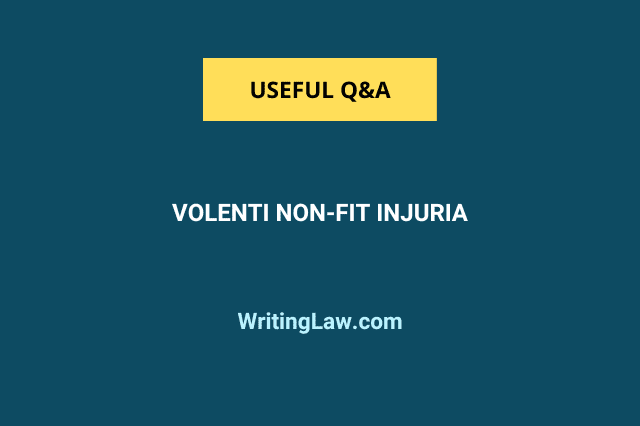Volenti Non Fit Injuria: Legal Concept Explained
We can all agree that legal concepts like "Volenti Non Fit Injuria" can be complex and confusing.
But understanding this key legal maxim doesn't have to be so difficult. In this post, you'll get a clear, practical explanation of Volenti Non Fit Injuria, including what it means, when it applies, and how it has been used as a legal defense.
You'll see real-world examples of Volenti Non Fit Injuria cases, learn the key elements required to establish this defense, and be able to distinguish Volenti from other related legal doctrines. By the end, you'll have a solid grasp of this critical negligence defense and its viability in court.

Understanding the Legal Maxim 'Volenti Non Fit Injuria'
Volenti non fit injuria is a Latin legal maxim meaning "to a willing person, no injury is done." It is a common law defence that can be used in tort law cases.
The principle behind volenti non fit injuria is that a person who willingly places themselves in a risky situation accepts that an injury might occur. By assuming this risk, they cannot then sue if an accident does happen.
So in situations where volenti non fit injuria is successfully argued, the defendant would not be liable for negligence as the claimant consented to the risks involved.
Volenti Non Fit Injuria Translation and Pronunciation
Volenti non fit injuria literally translates from Latin to English as:
"To a willing person, no injury is done."
It is pronounced:
vo-LEN-tee non fit in-JOOR-ee-ah
Volenti Meaning and Legal Relevance
As described above, volenti refers to a willing person who consents to a risky activity. By doing so, they assume responsibility for any resulting injury.
This legal maxim emerged from Roman law but became an established defence in English tort law. It is most commonly used in claims involving sports injuries or dangerous activities.
The key relevance of volenti non fit injuria is that it can provide a complete defence. If successfully argued, the defendant would bear no liability for any negligence on their part.
The Role of Consent and Assumption of Risk
Consent and assumption of risk are integral to the volenti defence.
For volenti to apply, the claimant must have fully consented to the activity while understanding and accepting the risks involved. This informed consent and voluntary assumption of risk provides the basis for the defence.
So if an accident does occur, the claimant cannot then sue for compensation. Their prior agreement to participate, acknowledging the dangers present, essentially waives their right to bring a negligence claim later on.
Ultimately, volenti non fit injuria asserts that people should take personal responsibility when they willingly engage in inherently risky pursuits, rather than trying to blame others if it goes wrong.
What is the case of Volenti non fit iniuria?
The legal doctrine of volenti non fit injuria, commonly translated as "to a willing person, injury is not done", establishes that a person who willingly places themselves in a position where harm might result cannot bring a claim against another party for any resulting damage. This is based on the principle that by consenting to undertake an action despite awareness of the risks, the injured party has implicitly agreed to waive their right to sue for any injuries sustained.
The doctrine has its origins in Roman law but became widely adopted in English common law. It functions as a complete defence in tort lawsuits involving negligence claims. If successfully argued by the defendant, it results in the plaintiff being barred from compensation even if the defendant is proven negligent.
For volenti non fit injuria to apply, several key elements must be satisfied:
- The plaintiff had actual knowledge of the risk and willingly assumed it
- The risk was sufficiently clear and unambiguous
- The plaintiff had adequate capacity to make the decision with full autonomy
The rationale is that it would be unfair to hold the defendant legally responsible when the plaintiff made an informed choice to encounter the risk. However, the plaintiff must have consented to the specific risk that caused the damage rather than just general awareness of potential dangers.
The doctrine continues to be frequently cited in lawsuits related to dangerous sports and activities. It also applies to some workplace accident litigation when risk factors were evident to the employee. Overall, volenti non fit injuria remains an important negligence defence in tort law.
What is the defense of Volenti non fit iniuria?
Volenti non fit injuria is a common law defense that means "to one who is willing, no harm is done." It is used in tort law cases where a plaintiff (the person bringing the lawsuit) has knowingly and willingly put themselves in a risky situation and thus assumed the risk of injury.
The key elements that need to be proven for this defense to succeed are:
- The plaintiff had actual knowledge of the risk and fully appreciated its nature and extent
- The plaintiff voluntarily agreed to encounter that risk
For example, if someone voluntarily participates in a dangerous sport like skydiving and gets injured, they typically cannot sue for damages since they willingly and knowingly assumed the risks involved.
So in summary, volenti non fit injuria provides a complete defense when it can be shown that the plaintiff knew about and accepted the risk that resulted in their injury. It is based on the legal and ethical principle that one cannot complain about self-inflicted harm that was understood and agreed to beforehand.
Which case did the defence of volenti non fit injuria succeed?
The defence of volenti non fit injuria, meaning "to a willing person, injury is not done", has succeeded in several notable cases in English tort law. Here is a brief overview of three key cases where this defence was successfully raised:
In Haynes v Harwood [1935] 1 KB 146, the plaintiff was injured during a game of cards when the defendant jokingly threw a small bun at him. The court held that the plaintiff had voluntarily consented to participate in the game and assumed the risk.
In Cutler v United Dairies [1933] 2 KB 297, the plaintiff was a milk roundsman who continued working despite knowing his horse was vicious. He was kicked and injured by the horse. The court ruled that he voluntarily assumed the risk by continuing to work with a known danger.
In Nettleship v Weston [1971] 2 QB 691, a learner driver injured her instructor. The court held that as an instructor, he had consented to take the risk of injury from a learner's potential mistakes.
So in all three cases, the defence succeeded because the plaintiffs had willingly assumed obvious risks that resulted in their injuries. The courts deemed that since they consented to face those dangers, they could not later seek damages.
What is the difference between contributory negligence and volenti non fit injuria?
Volenti non fit injuria is a complete defence in tort law, while contributory negligence only reduces the amount of damages a plaintiff can recover.
Volenti Non Fit Injuria
Volenti non fit injuria means "to a willing person, no injury is done." It is a full defence that bars a plaintiff from any recovery if they voluntarily assumed the risk that resulted in their injury.
For volenti non fit injuria to apply, the plaintiff must have:
- Full knowledge of the nature and extent of the risk they were undertaking
- Voluntarily agreed to accept that risk
If proven, it acts as a complete defence, meaning the plaintiff cannot recover any damages from the defendant, even if the defendant was negligent.
Contributory Negligence
Contributory negligence occurs when the plaintiff's own negligence contributed to their loss or injury. For example, if a plaintiff failed to take reasonable precautions to protect themselves, and this failure contributed to their injury.
Contributory negligence is not a complete defence. It only reduces the amount of damages the plaintiff can recover in proportion to their degree of fault. So if a plaintiff was found 25% responsible for their own injury due to their contributory negligence, their damage award would be reduced by 25%.
The key difference is volenti non fit injuria bars all recovery, while contributory negligence only reduces damages proportionate to the plaintiff's fault.
sbb-itb-e93bf99
The doctrine of volenti non fit injuria in negligence defences.
The legal doctrine of Volenti non fit injuria, often referred to by its Latin name, establishes consent or assumption of risk as a defence in negligence cases. Translating to "no injury is done to one who consents," it means that one cannot bring a claim if they willingly placed themselves in a risky situation. However, its applicability as a full or partial defence is complex.
Is Volenti Non Fit Injuria a Complete Defence?
Volenti non fit injuria can potentially act as a complete defence in English tort law, eliminating liability for negligence. However, for it to apply, the plaintiff must have fully understood and voluntarily accepted the risk that resulted in damage or injury. If established, it can completely bar a claim.
However, courts increasingly consider it a partial defence used alongside contributory negligence principles to reduce damages. This accounts for negligence on both sides rather than eliminating liability. So in practice, while theoretically a full defence, Volenti often combines with other defences.
Volenti Non Fit Injuria vs. Comparative Negligence
Comparative negligence differs from Volenti in that it apportions percentages of fault rather than barring claims. If both parties acted negligently, damages get reduced based on each party's contribution to the damage. However, if the plaintiff fully comprehended and accepted the risk under Volenti, it can still completely bar a claim regardless of the defendant's negligence.
So while comparative negligence reduces damages proportional to fault, Volenti focuses strictly on the plaintiff's actions without considering the defendant's negligence. In some cases, Volenti and comparative negligence may apply concurrently to account for consent alongside shared liability.
Acts of the Claimant and Consent
For Volenti to apply as a defence, the plaintiff's actions must demonstrate full awareness and voluntary acceptance of the particular risk. This consent eliminates the duty of care and prevents claiming compensation for associated damage.
Reckless conduct itself does not necessarily indicate consent. Plaintiffs must have actual knowledge of the specific risk that caused the injury and willingly encounter it for Volenti to succeed as a defence. Simply acting negligently does not amount to consent. So the applicability of the Volenti doctrine heavily emphasizes the claimant's state of mind and scope of consent.
Volenti Non Fit Injuria in Specific Contexts
Explore the application of the Volenti doctrine in various legal contexts, such as sports and property law.
Volenti Non Fit Injuria in Sports
The Volenti non fit injuria defence is commonly used in cases involving injuries sustained during sporting activities. Participants in sports are generally deemed to have consented to the inherent risks involved. However, the consent is not absolute. The defence applies only to foreseeable risks that are an accepted part of the sport. Reckless or intentional acts that cause injury may still lead to liability.
Factors considered by courts include the rules of the sport, the skill level of participants, safety equipment used, and more. For example, in Haynes v Harwood, a professional jockey was denied damages for injuries suffered during a horse race, as he was aware of and accepted the risks. However, overly dangerous conduct may exceed the scope of consent.
Volenti Non Fit Injuria Occupiers' Liability
The Volenti doctrine can interact with the Occupiers’ Liability Act 1984 in premises liability cases. Where a visitor engages in an activity with full knowledge and awareness of risks on an occupier’s premises, they may be deemed to have consented to potential injury.
However, s.2(3) of the Act states that warning signs do not, in themselves, exclude an occupier’s duty of care. The visitor’s consent must be informed and voluntary. If occupiers fail to adequately warn visitors or mitigate risks, Volenti may not apply as a defence.
Employment and Volenti Non Fit Injuria
In the employment context, the Volenti defence is restricted in its application. Employers have a duty of care to provide a safe working environment. Employees do not consent to excessive risks merely by agreeing to work. However, if employees voluntarily engage in inherently high-risk activities against advice, the defence may succeed.
Overall, the applicability of Volenti non fit injuria depends heavily on the specific facts and context of each case. It is not an absolute defence but rather requires judges to conduct a nuanced evaluation of what risks were reasonably foreseeable and consented to by claimants.
Establishing the Defence: Key Elements and Burden of Proof
To successfully establish the Volenti defence, the defendant must prove certain key elements. These include:
Proving Informed Consent
The defendant must show that the plaintiff had full knowledge of the risk and voluntarily consented to it. This means proving:
- The plaintiff was aware of the nature and extent of the risk
- The risk was clear and unambiguous
- The plaintiff voluntarily agreed to accept the risk
The defendant bears the burden of proving informed consent. They must show consent was given with full appreciation of the dangers.
Demonstrating Voluntary Assumption of Risk
The defendant must also demonstrate the plaintiff voluntarily assumed the risk that resulted in damage. Key factors in determining voluntariness include:
- Absence of coercion or pressure
- Whether a reasonable alternative was available
- The plaintiff's age and capacity
If consent was obtained by force or coercion, the defence will fail.
Exclusion of Coercion in Consent
Consent must be given freely and voluntarily, without coercion or duress. If the plaintiff felt obliged to accept the risk, the defence will not succeed. Factors considered include:
- Imbalances of power in the relationship
- Whether consent was gained through deception
- If refusing consent had negative consequences
Coerced consent invalidates the defence. The defendant must prove consent was given entirely freely.
Legal Precedents and Landmark Cases
Review significant cases that have shaped the understanding and application of the Volenti non fit injuria defence.
Case Analysis: Haynes v. Harwood
The Haynes v. Harwood case in 1935 established that the defence of volenti non fit injuria applies even where the plaintiff is not fully aware of the nature or extent of the risk. In this case, the plaintiff (Haynes) knew there was some risk of injury from participating in a dangerous sport but did not have full knowledge of the risk. However, the court still held that by willingly participating, he had accepted the risk and could not sue for damages.
This precedent widened the scope of the volenti defence by not requiring plaintiffs to have complete understanding of the risks. It meant that as long as a reasonable person would have recognized the existence of some danger, that is enough for volenti to potentially apply.
Case Analysis: Nettleship v. Weston
The 1971 case of Nettleship v. Weston was significant in establishing that even learners and beginners could be covered under volenti non fit injuria. In this case, the plaintiff (Nettleship) allowed the defendant (Weston), a complete novice at driving, to drive a car. The defendant crashed the car, injuring the plaintiff.
The court ruled that despite Weston's inexperience, Nettleship had willingly accepted the obvious risks of allowing an unskilled driver to operate the vehicle. By consenting to ride with Weston, Nettleship took responsibility for any potential injuries.
This expanded the defence to apply even when the defendant lacks skill, experience or knowledge, as long as the plaintiff understands the general nature of the risks involved.
Case Analysis: Tomlinson v Congleton Borough Council
In the 2003 Tomlinson v Congleton Borough Council case, the court determined that the volenti principle only applies to risks that are inherent to an activity. If the injury arises from a danger outside the ordinary risks, consent can not be inferred.
In this case, Tomlinson suffered catastrophic brain injuries after diving into a lake whose depth he did not realize. The court ruled that this hidden danger went beyond the typical risks of swimming and diving. By distinguishing between inherent and extraneous risks, the precedent narrowed the scope of volenti non fit injuria.
Case Analysis: Ratcliff v McConnell
The 1999 case of Ratcliff v McConnell introduced the concept of ���comparative knowledge” in determining whether volenti applies. It established that the plaintiff must have actual knowledge of the particular risk that caused the injury - not just general awareness of some danger.
In this incident, Ratcliff (an experienced horse rider) was injured after a horse bolted out of control with McConnell (a novice rider) on board. The court ruled that despite Ratcliff's general experience with horses, she did not have full understanding of the specific risk posed by McConnell's inability to control the horse.
This added a nuanced comparative knowledge assessment in applying volenti, requiring plaintiffs to be informed of the precise danger that manifested, even if they recognized broader risks.
Comparative Analysis with Other Legal Doctrines and Principles
The Volenti non fit injuria principle establishes that a person who willingly places themselves in a risky situation cannot sue for any resulting injuries. This legal doctrine has important relationships with other core principles in tort law.
Distinguishing Volenti from Contributory Negligence
Contributory negligence suggests a plaintiff's failure to exercise reasonable care contributed to their injuries. However, it only reduces damages proportionately. Volenti provides a complete defence by barring claims entirely. Further, Volenti applies even without negligence by the defendant. The key distinction is voluntary assumption of risk under Volenti versus carelessness by the plaintiff under contributory negligence.
Volenti and the Defence of Consent
Consent provides a defence against battery and similar intentional torts. The plaintiff's permission absolves liability. Similarly, Volenti bars claims if the plaintiff accepted known risks. However, Volenti only covers injuries from inherent dangers in an activity. Separately, consent applies to intended contact by the defendant regardless of inherent risks.
The Interplay between Volenti and Occupiers' Liability
The Occupiers' Liability Act 1984 limits property owners' duty of care to visitors who willingly accept risks. This aligns with Volenti. However, the Occupiers' Liability Act only reduces liability. Volenti completely eliminates claims. Further, Occupiers' Liability relies on posted warnings, whereas Volenti focuses on plaintiffs' actual awareness of dangers.
In summary, while Volenti shares aspects with other defences, its scope is distinct in barring injury claims when plaintiffs knowingly and voluntarily assume inherent risks in activities. Understanding its intersections and departures from related legal principles is key to applying Volenti appropriately.
Conclusion: The Viability of Volenti Non Fit Injuria as a Negligence Defence
The Volenti non fit injuria doctrine establishes that plaintiffs who willingly assume the risk of harm cannot sue for any resulting injuries. While a potentially useful negligence defence, its applicability depends on the specific circumstances of each case.
Recapitulation of the Volenti Doctrine
The key principles of Volenti non fit injuria include:
It applies when the plaintiff has willfully accepted a known risk of harm. This consent can be express or implied.
The defense argues the plaintiff cannot sue for injuries resulting from risks they agreed to take on.
Volenti has been applied in cases involving sports injuries, dangerous jobs, and hazardous premises.
There are limitations around minors, intoxication, and what constitutes valid consent.
Assessing the Strength of Volenti as a Defence
When applicable, Volenti can fully absolve defendants of liability. However, its viability as a defence depends on several factors:
Meeting the burden of proof for valid consent and awareness of risks.
The reasonableness of plaintiff's actions given the circumstances.
Whether contributory negligence or comparative negligence doctrines apply.
Ultimately, Volenti non fit injuria remains situationally useful but hard to guarantee as an airtight defence against negligence claims.
Related posts
- Furiosi Nulla Voluntas Est: Legal Concept Explained
- Negligence: Legal Concept Explained
- Non Est Factum: Legal Concept Explained
- Ignorantia Juris Non Excusat: Legal Concept Explained
Legal Document Reviewer Salary in the US: Unpacking the Pay in Critical Case Analysis

NextChapter vs LawMatics: A Comparative Review

Filevine vs NextChapter: A Comparative Review
volenti non fit injuria
Primary tabs.
Volenti non fit injuria is Latin for “to a willing person, it is not a wrong.” This legal maxim holds that a person who knowingly and voluntarily risks danger cannot recover for any resulting injury . This principle was the common-law basis for the assumption of the risk doctrine.
[Last updated in August of 2021 by the Wex Definitions Team ]
- LIFE EVENTS
- accidents & injuries (tort law)
- standards of tort liability
- tort damages
- wex definitions
- Law of torts – Complete Reading Material
- Weekly Competition – Week 4 – September 2019
- Weekly Competition – Week 1 October 2019
- Weekly Competition – Week 2 – October 2019
- Weekly Competition – Week 3 – October 2019
- Weekly Competition – Week 4 – October 2019
- Weekly Competition – Week 5 October 2019
- Weekly Competition – Week 1 – November 2019
- Weekly Competition – Week 2 – November 2019
- Weekly Competition – Week 3 – November 2019
- Weekly Competition – Week 4 – November 2019
- Weekly Competition – Week 1 – December 2019
- Sign in / Join

- Law of torts - Complete Reading Material
Volenti Non Fit Injuria

This article is written by Adarsh Singh Thakur, student, Indore Institute of Law, Indore.
Introduction
In the law of torts, if any person commits any wrongful act which causes injury to another person, he is held liable and has to pay damages or provide some other remedy which the Court determines, to the victim of such an act.
But in some cases even if a person suffers some loss because of the act of another person, he cannot claim damages from that person because of the operation of defences of tort. One such defence available to a defendant is the defence of volenti non fit injuria in which the plaintiff is not entitled to damages because he consents to the act which has caused injury to him.
What is volenti non-fit injuria?
In the law of torts, there is a duty on every person do acts with reasonable care in order to avoid any harm which may occur due to their failure of taking such care. For e.g., If a person is driving his car, he has a duty to drive the car safely and within speed limits so that no accident occurs which can also harm any other person.

This is the general rule in torts but there are certain exceptions which are allowed in these cases and these called as defences to tort. Under these defences, a defendant can escape liability and volenti non-fit injuria is also one such defence which is available for the defendant.
In case a person gives his consent to doing of an act which leads to him getting injured, then even if an injury is caused by the other person, he cannot claim any damages from that person because the act was one for which he voluntarily consented. The consent of the plaintiff acts as a defence and this defence is called volenti non fit injuria which means to a willing person no injury happens.
Illustration: If A has a bike whose brakes do not work and B knowing about the conditions of the bike still chooses to sit on it with A driving it and due to the failure of such brakes they both sustain injuries in an accident, B cannot claim relief from A because he had voluntarily consented to sit on the bike.
But in the above illustration, if B was not aware of the conditions of brakes and then he sustained injuries sitting in it, he would not be stopped from claiming damages from A because here B did not give his consent to accept the risk of getting injured due to failure of the brakes.
Elements of Volenti non-fit injuria
For the application of the defence of volenti non fit injuria there are some essential elements or conditions which should be present in a case and only when they are fulfilled, this defence can be taken to prevent liability.
There are 2 essential elements in this defence:
- The plaintiff has the knowledge of the risk
- The plaintiff with the knowledge of risk has voluntarily agreed to suffer the harm.
Thus, whenever the plaintiff is aware of the possibility of harm which is likely to be caused by an act and when he still accepts to do that act and therefore agrees to suffer the injury, a defendant is relieved of his liability.
But only having knowledge about the risk is not enough for the application of this defence, It is known as Scienti non fit injuria, which means that mere knowledge does mean consent to the risk. Thus having knowledge is only a partial fulfilment of the conditions for the application of volenti non fit injuria.
Illustration: A goes for bungee jumping and he knows that he might get injured by it but he still decides to do it and as a result, he suffers injury despite all the necessary care being taken by the organisers. Here A cannot claim damages from the organisers because he had full knowledge of the risks and he had voluntarily agreed to suffer that injury by choosing to do bungee jumping.
In Smith v. Baker & sons, (1891) AC 325, the plaintiff was an employee of the defendant and the site where he used to work had a crane which carried rocks over their heads. The plaintiff had also complained to the defendant about it. One day the plaintiff was injured because of these rocks falling on him and thus he sued the defendant for damages. It was held that the defendant was liable and had to pay damages to the plaintiff because the plaintiff had consented to the danger of the job but not to the lack of care.
Burden of proof
In the cases where the defendant is taking the defence of volenti non fit injuria, the burden of proof is on him to show that the plaintiff had full knowledge of the act and he had consented to the risk involved in the act and the defendant has to show that the plaintiff was also aware of the extent of risk which was involved in the act for successfully taking this defence.
Illustration: A has to undergo an operation for his eye infection and the doctor fails to inform him about the risk of losing his vision due to the operation, as a result, A takes the operation believing that there is no such risk to his eye. In the operation, if A loses his eyesight, the doctor will be held liable because A did not have the knowledge about the extent of the risk which was involved in the operation and therefore, the defence of volenti non-fit injuria cannot be taken.

Consent of the plaintiff
The consent of the plaintiff is very important in the defence of volenti non fit injuria because only when he voluntarily gives his consent to an act, the defendant can take this defence.
In the case of Hall v. Brookland (1932) All E.R. Rep 208, the plaintiff went to see a car race in which two cars collided with each other and as a result of the collision, the plaintiff who was sitting as an audience was also injured when one of the cars flew into the audience. Here the defence of volenti non fit injuria was applied because the plaintiff had given his consent to such a risk by going to the race.
Consent may be Express or Implied
In the cases of this defence, the consent of the defendant is not required to be expressly given and even by his conduct, his consent can be taken.
Illustration: C is a cricket player and due to a full toss ball he gets hits by it on his shoulder. Here C cannot claim any damages because C has consented to the risk by agreeing to play cricket.
Illustration: A goes to watch a cricket match and while watching the match the batsman hits a six that hurts A’s hands when he attempts to catch it. Here A cannot hold the batsman or the owner of the Cricket stadium liable because he had impliedly consented to this injury by his act of purchasing the ticket and sitting in the stadium and thus despite no express consent, the defence of volenti non fit injuria will apply here and his consent will be deemed to be implied for such injury.
Consent of the Plaintiff must be free
When a plaintiff gives his consent for an act such consent should be free from any coercion, fraud or any other such means by which the free consent can be affected.
For e.g., A has a heart problem and he goes to a hospital for surgery. There he is informed by the surgeons that the required surgery is very complicated and there is a chance of the surgery failing which can cause his death. If A gives his consent to have the surgery and the surgeon despite taking all reasonable care in doing the surgery is not able to save A, then the surgeon cannot be held liable because A had given his consent for it and this consent was given freely.
In case the consent of a person is not free, the defendant cannot claim this defence to escape liability and he will be held liable for damage caused.
For e.g., A having heart problem goes to a surgeon and he is told that he needs surgery to which he agrees. During the surgery, the surgeon removes one kidney of A without his knowledge. In this case, even though the surgery is successful the surgeon will be held liable because A did not give his consent to the removal of his kidney.
In the case of Ravindra Padmanabhan (Dr.) vs Lakshmi Rajan And Anr. , the plaintiff had a tumour on her breasts and therefore she went to the hospital to have it removed. While operating her the doctor also removed the uterus even though it had nothing to do with the tumour. Thus, the Court held the defendants liable and thus, the defence of volenti non fit injuria was rejected.
In the case of Padmavati v. Dugganaika , the plaintiffs had asked for a lift in the jeep of the defendants and while travelling in it one of the screws of the wheel of the jeep fell out, as a result, the jeep crashed and it caused the death of one of the plaintiffs. In the case, the Court held that the defence of volenti non fit injuria will apply and thus the defendants were not liable because by sitting in the jeep the plaintiffs had assumed the risk of being injured in an accident.

Consent by fraud
In cases of consent having been obtained by fraud, the defence of volenti non fit injuria will not apply and the defendant will be held liable for the wrong by him.
For e.g., in the case of R v. Williams (193) 1 KB 340, the defendant was a singing coach and he had convinced a 16-year-old student to have sexual intercourse with him by telling her that it will help her in improving her voice and singing. The defendant was held liable by the Court because the consent was obtained by fraud.
Consent in cases of intentional infliction of harm
In the cases where harm is caused to a person intentionally, the defence of volenti non fit injuria will apply if the person has given his consent to such harm.
Illustration: A is a boxer who is fighting B in a boxing match. During the match, B punches A very hard as a result of which he suffers head injuries. In this case, even though B had intentionally inflicted harm on B it will not make B liable because A had willingly given his consent.
Illustration: K is a football player and during a match, he gets injured due to a tackle another player, as a result of which he needs surgery. Here A cannot claim any damages because by playing the sport he has impliedly consented to the risk of being injured.
Limitations on the application of volenti non fit injuria
There are certain limitations under which the defence of volenti non fit injuria cannot be taken by a defendant even if the essentials of this defence are present in the case.
Rescue Cases
When the plaintiff suffers an injury as a result of him doing an act which he knows is likely to cause harm to him but it is an act to rescue someone, then this defence will not apply and the defendant will be held liable.
Illustration: A fire is caused due to the negligence of A, and B is trapped inside the fire. C sees B and jumps into the fire to rescue him but in doing so he is also burned. Here even though C went into the fire voluntarily, knowing fully well that he may be burned, A will be held liable for negligence and the defence of volenti non fit injuria cannot be applied in this case, therefore, C will is entitled to receive damages from A.
In the case of Haynes v. Harwood (1935), 1 KB 146, the servant of the defendant brought two horses in the town near a police station and left them to do some other work. The horses were upset by the children and they broke free, seeing them in rage the plaintiff who was a police officer went to stop the horses and in doing so he got injured and brought a case against the owner for damages. The court held the defendant liable because the defence of volenti non-fit injuria did not apply in a rescue case.
Illegal Acts
If the consent is given for an act which is not allowed by law then, even on the fulfilment of all the essential conditions of this defence, the liability cannot be escaped and thus in such cases, this defence becomes inoperative.
Illustration: If A and B decide to do a fight with sharp swords, when such an act is prohibited by law, and A suffers a big cut due to which he suffers serious injuries, then in such case B cannot take the defence of having A’s consent in doing this act because it was prohibited by law and thus B will be liable.
Negligence of the defendant
The defence of volenti non fit injuria is not applicable in a case where the defendant has been negligent. Thus only where there is no negligence by the defendant, he can claim this defence to escape liability.
Illustration: If A goes undergoes a heart operation and he gives his consent for it even though he knows that there is a risk of the operation failing which can cause his death, the surgeon will not be liable if A dies as a result of the surgery if he had taken all due care. But if the operation had failed because of the negligence in carrying out the surgery then in such a case, the surgeon cannot claim the defence of having received the consent of A and he will be liable because there was negligence on his part in conducting the surgery.
In the case of Slater v. Clay Cros Co. Ltd. 1956] 2 QB 264, the plaintiff was hit by a train in the tunnel of the defendant railway company. The railway company had given instructions to all the drivers of its trains that they have to blow the whistle at the entrance of the tunnel and they should also slow the speed of the train but the driver did not follow these instructions and negligently drove it inside the tunnel, as a result, the plaintiff was injured. The defendant had taken the defence of volenti non fit injuria but the Court held that this defence could not be applied because even though the plaintiff took the risk of walking inside the tunnel, this risk was enhanced by the negligence of the driver. Thus, when a plaintiff gives his consent to take some risk, there is a presumption that the defendant has not been negligent.
Volenti non fit injuria and Contributory negligence
Both contributory negligence and volenti non fit injuria are used as a defence by the defendant to escape liability but they differ from each other.
In contributory negligence, the plaintiff who has suffered an injury is also at fault along with the defendant and therefore the quantum of damages which he can be awarded is reduced in proportion to the degree of his negligence in the act which caused him injury. Thus, both the parties are at fault in such a case and therefore this is a partial defence available to the defendant.
Illustration: A gets hit by a car while crossing a road, which was being driven by B and he drove it rashly and over speed limit due to which A sustained many injuries. But this accident happened because A decided to cross the road even though the traffic signal was on and thus the pedestrians could not cross it until the signal stopped for the vehicles. Here both A and B are at fault and therefore even though B will be held liable, the damages which he has to provide will be reduced because A was also at fault and thus the defence of contributory negligence applies here,
In volenti non fit injuria, the defendant is completely exempted from his liability because of plaintiff’s consent and thus it is a total defence.
Volenti non fit injuria is one of the defence under the law of torts in which the person who has committed a wrong is exempted from liability because the victim of such a wrong gives his consent to the commission of such an act and such a consent must be free for the successful application of this defence in a case.
This defence is also subject to certain limitations such as rescue cases and the negligence of the defendant in which even if the consent is given by the plaintiff, the defendant is held liable.
Thus while allowing this defence, Courts have to ensure that the conditions of this defence are fulfilled and the act is not one which falls within the limitation imposed on this defence.
Students of Lawsikho courses regularly produce writing assignments and work on practical exercises as a part of their coursework and develop themselves in real-life practical skills.
LawSikho has created a telegram group for exchanging legal knowledge, referrals, and various opportunities. You can click on this link and join:
https://t.me/lawyerscommunity
Follow us on Instagram and subscribe to our YouTube channel for more amazing legal content.

RELATED ARTICLES MORE FROM AUTHOR
Arvind @ abasaheb ganesh kulkarni vs. anna @ dhanpal parisa chougule (1980), state of punjab vs. major singh (1966), section 139 of negotiable instruments act, 1881 , leave a reply cancel reply.
Save my name, email, and website in this browser for the next time I comment.
3-Day Bootcamp on (LIVE only)
How to kickstart your international IP law career today

Register now
Thank you for registering with us, you made the right choice.
Congratulations! You have successfully registered for the webinar. See you there.

Lex-O-Pedia
- Login / Join
Know what is hot in the legal fraternity and governance. We curate everything going around in Legal aspects of the country.
Recent Posts

Trending Posts

Editorial picks from the Team behind Legal Wires and from the desk of the Editorial Team. This section is dedicated to the vision of Legal Wires behind starting it.

Case study of popular cases with in depth analysis and opinion of various personalities.

To help you understand the legal terminologies we will curate and describe every single word out there. With detailed definitions and references we will make it Encyclopedia of Legal Terms.

Know how the Industry leaders think and act according to any situations. We will curate the best interviews with detailed questionnaire that will guide all aspirants in the right direction.

At Legal Wires, we aim to bring all the materials you can read and learn from. We will give you multiple perspectives and educating articles.

Jul 4, 2024 05:00 UTC
Jul 4, 2024 at 05:00 UTC
Study Notes: Volenti Non Fit Injuria
This maxim has a Latin origin and translates to “ to a willing person, it’s not a wrong” . It’s a common law doctrine that is observed in practice in law of torts as a general defence. It implies that an individual cannot complain of harm which he has exposed upon himself with knowledge and a free will. For instance, when an individual participates in an activity of paragliding, he provides his conformity towards the risks involved in that act and cannot thereafter sue for damages/ harm upon occurrence. Consent to waive a right can be either expressed or implied. For the defence to be valid, the defendants must demonstrate that the plaintiff was fully informed about the risk and its magnitude. Simply knowing about the risk is insufficient; the plaintiff must also consent to endure the potential harm.
There are certain elements that need to be established when obtaining a defence under the doctrine of volenti non fit injuria:
1. Consent towards risk : Consent is the most important element; it implies that the claimant must have given a free consent to the risk of harm in observance of the act concerned due to which the harm was caused. This factor produces that the individual (claimant) has willingly and knowingly taken upon the impact and establishes fairness by balancing responsibility and preventing other individuals (defendant) from being held liable and thus hindering unjust claims of compensation. However only a free consent would be valid and that obtained through fraud, misrepresentation or any other malicious act would amount to intentional infliction of harm and the principle of Volenti Non Fit Injuria will cease to take effect.
In the case of Hall v. Brooklands Auto Racing Club [1] , the plaintiff was at a motor racing event, where an accident took place when two cars collided, one of the cars crashed into the spectator’s area and caused injuries to the plaintiff. The plaintiff held the racing club liable for the injuries but the court decided on the application of Volenti Non Fit Injuria and made its judgment holding the plaintiff liable as by attending the event he voluntarily accepted the risks and was deemed to have given consent for the same.
2. Knowledge of risk : The claimant must possess full knowledge of the nature and extent of the risk. The presence of this element further induces that the claimant undertook the act after due assessment of the probability of the harm, its nature and was not exposed to it suddenly without prior information. The above two elements must exist simultaneously. Having mere knowledge is only a partial fulfillment of conditions.
In the case of Smith v. Baker & sons [2], the plaintiff worked at a construction site owned by the defendant. He was hurt due to falling rocks through the overhead crane and claimed damages. It was established that the defendant was liable as mere knowledge of the crane does not amount to a consent towards probable risk.
Similarly in the case of Lakshmanan v. Valliammal [3], the plaintiff attended a religious festival which included a fire walking ceremony, while the same was being conducted the plaintiff caught fire and suffered injuries and held the organizer liable. The court reinforced the principle of volenti and reasoned that the plaintiff willingly assumed the risk by being present there.
3. Voluntary assumption : The claimant must have voluntarily assumed the risk which essentially means that they had a genuine choice in matter and opted to continue after weighing alternate choices.
This could be understood through Morris v Murray [4] in which the claimant and defendant were drinking together, further the claimant agreed to fly with the latter and the plane crashed. It was later developed that the defendant was not liable for the damages as the claimant knew of the intoxication and thereupon voluntarily assumed the risk to fly given the condition.
In the case of Padmavati v. Dugganaika [5], the plaintiff was traveling with the defendant in his jeep as a gratuitous passenger, when suddenly the vehicle got in an accident and the plaintiff sustained injuries and sought compensation from the defendant for the same. The court released the defendant from liability and highlighted the application of the VNFI doctrine in situations where individuals voluntarily accept risks associated with their actions.
When the defendant claims the exemption from liability under this doctrine the burden of proof that is the responsibility of furnishing that all the essentials are constituted lies on the defendant himself against the claimant.
Given the brief above, there are certain limitations to this doctrine as well which are as follows:
1. Capacity to contract : If the claimant lacks the capacity to contract; is a minor, heavily intoxicated or of unsound mind the ability to anticipate the risk and its nature is likely to be affected and hence the existence of such a factor works as an exception.
2. Illegal acts : Consent to an act that lies in opposition to the law prevailing does not rule out the liability and this principle is hence inapplicable.
3. Rescue case : This doctrine takes a back seat when acting out of duty and necessity in rescue cases as the individual is said to undertake the act out of necessity rather than voluntary assumption, and hence the rescuer holds the right to claim remedy. In the case of Haynes v. Harwood[6] , the defendant owned a horse drawn cab, which he left unattended due to which the horse bolted and caused a commotion in the street. The plaintiff intervened to prevent further damages and suffered injuries while attempting the same. Court held the defendant liable for the injuries.
4. Statutory Protection : Certain statutes may override the volenti Defence, especially in cases involving employees or consumers. For example, health and safety regulations mandate employer responsibilities regardless of employee consent.
5. Consent: If the consent of the claimant is not fully obtained or if obtained through fraud, deceit, misrepresentation then the doctrine of Volunti Non Fit Injuria will lose its force and such person responsible will be held liable for the act.
In Lakshmi Rajan v. Malar Hospital [7], a lady visited the hospital to get a fibroid removed from her body, while executing that procedure the surgeons removed her ovaries which was neither linked to the fibroid nor was such an act discussed with the patient beforehand. The patient held the doctors liable. The court suspended the defense of the latter sought under Volenti non fit injuria and laid emphasis on informed consent of the patient.
Also in the case of R v. Williams [8], the defendant was a music teacher who deceived his student (plaintiff) to believe that she would experience improvement in her voice if she agreed to have sexual intercourse, the court held Williams guilty of rape as the consent was obtained through deceit and was not free in nature thereby suspending the concept of Volunti Non Fit Injuria.
Volenti non fit injuria is a crucial doctrine in tort law as it lays an emphasis towards the burden of liability, it falls on the claimant rather than the defendant if the latter succeeds in establishing the essentials and discharges himself of the liability which then transfers to the claimant himself. Volenti Non Fit Injuria offers a limited defence in tort law. It shields defendants from liability when the plaintiff willingly accepts inherent risks. This upholds individual choice but requires the consent to be free. The defendant’s conduct also matters; outrageous behaviour can still incur liability. While still relevant, Volenti’s importance has diminished in some areas as contributory negligence offers a more proportional approach.
[1] (1932) 1 KB 205.
[2] (1891) AC 325.
[3] AIR 1991 Mad 310.
[4] [1990] 3 All ER 801.
[5] AIR 1975 Kant 204.
[6] [1936] 1 KB 146.
[7] AIR 1998 Mad 323.
[8] [1923] 1 KB 340.
Disha Bhardwaj
Related posts.
READ MORE 3 days ago
READ MORE 2 months ago
READ MORE 2 years ago
READ MORE 3 years ago
top Trending posts

Study Notes: Winding Up of Companies

Case Study: Bar of Indian Lawyers through its President Jasbir Singh Malik v. D. K. Gandhi PS National Institute of Communicable diseases and Anr.

Study Notes: Doctrine of Constructive Notice

Case Study: Salomon v. A. Salomon and Co. Ltd.

Case Study: Badshah v. Urmila Badhshah Godse and another

Case Study: Ruben and Anr v. Great Fingall Consolidated and Ors

Case Study: Mahony v. East Holyford Mining Co.

Case Study: Dev Kishan and Ors v. Ram Kishan and Ors.

Case study: Arshnoor Singh v. Harpal Kaur and others

Dalit Horrors Remembrance Day: Commemorating the weeks into 75th Independence Day

Decoding Fashion Industry: Need for Fashion Law
Legal Wires is an Online Electronic Media Portal, dedicated to Public Education and Critical Legal Analysis of the trending discourses of National and International importance.
- Human Rights
- Constitutional Law
- Competition Law
Copyright © Legal Wires 2020
- Privacy Policy
- Terms & Conditions
IPSA LOQUITUR
Tort: Volenti Non Fit Injuria
Volenti non fit injuria, establishing the defence, the requirements.
To establish the defence of volenti non fit injuria , the defendant must show that:
- The claimant had fully-informed knowledge about the risk; and
- The claimant voluntarily agreed to waive their right to sue if the risk manifested, or otherwise indicated that they assumed the risk themselves and so would not sue: Nettleship v Weston [1971] 2 QB 691.
Ordinarily, an express indication that the claimant is waiving their right to sue is needed. However, the courts will sometimes infer that the claimant has voluntarily assumed responsibility for their risk from their actions.
Fully-Informed Knowledge
The claimant must be capable of appreciating any obvious risks and understanding what he is doing. This may not be the case if he is too drunk or incapacitated. It is not enough that the claimant is merely disinhibited, however: Morris v Murray [1991] 2 QB 6.
It does not matter that the claimant, having understood the risk, thought that it would nor happen to him: Imperial Chemical Industries Ltd v Shatwell [1965] AC 656.
The courts are generally reluctant to imply a waiver, without express agreement, from the mere fact that the claimant engaged in a risky activity with knowledge of the risk: Smith v Baker [1891] AC 325. However, the court may infer a waiver in cases based on the following factors:

If their employer ordered the claimant not to perform the action, whether serious measures were taken to enforce the order or the claimant was under pressure or encouragement from a superior to do the act: Imperial Chemical Industries Ltd v Shatwell [1965] AC 656.

The claimant incited, co-operated or assisted the defendant in creating the risk (with knowledge that what he was doing was risky): Morris v Murray [1991] 2 QB 6.

There was no need (beyond the claimant’s entertainment) or compulsion for the claimant to do the risky act: Morris v Murray [1991] 2 QB 6.

The risk was serious and obvious: Morris v Murray [1991] 2 QB 6.

Possibly where there was no social or physical inconvenience in avoiding the situation, though this is a weak factor which must be supported by others: Dann v Hamilton [1939] KB 509.
This will be a determination based on degree and the facts of the particular case.
When Does the Defence Not Apply?
Protective duties.
The defence of volenti non fit injuria cannot be relied on where the purpose of the defendant’s duty was to protect the claimant from doing the relevant risky action: Kirkham v Chief Constable of Greater Manchester [1990] 2 QB 283.
Motor Vehicle Accidents
Volenti non fit injuria is unavailable where the claimant is the passenger in a motor vehicle accident: Road Traffic Act 1988 , s 149(3).
Volenti Non Fit Injuria Quiz
Test yourself on the principles of volenti non fit injuria .
What is the effect of establishing the defence of volenti non fit injuria ?
Incorrect . Volenti non fit injuria is a complete defence.
What factors are relevant to whether the claimant waived liability for risk for the purposes of volenti non fit injuria ? (Five answers)
Incorrect .
When is the defence of volenti non fit injuria unavailable to the defendant?
Can a defendant rely on the defence of volenti non fit injuria if the claimant understood the risk but was disinhibited by drugs or drink?
Incorrect . Drink or drugs are only relevant if they impair the claimant's ability to understand or appreciate the risk: Morris v Murray.
What two matters must the defendant show to establish the defence of volenti non fit injuria ?
Incorrect . See Nettleship v Weston.
Your score is
Share this:
Volenti Non Fit Injuria - A Conceptual Analysis
Legal Encyclopaedia (ISBN: 978-81-943164-1-1), Volume 1, Edition 1 (2020)
Posted: 2 Oct 2020
Rajas Salpekar
Independent
Date Written: Feb 1, 2020
A tort can take place in forms of trespass, battery, assault, malicious prosecution, defamation or any other form. However, a person can evade tortious liability even after himself committing the wrong by resorting to several defenses like ‘act of god’ , ‘plaintiff is the wrongdoer’, ‘inevitable accident’ and several others.One such defense against any tortious act is ‘voleni-non-fit-injuria’. This paper talks about the concept, history, exception and nuances of 'Volenti-Non-Fit-Injuria'.
Keywords: Volenti Non Fit Injuria, Torts, Ulpian, Scienti Non Fit Injuria
Suggested Citation: Suggested Citation
Rajas Salpekar (Contact Author)
Independent ( email ), do you have a job opening that you would like to promote on ssrn, paper statistics, related ejournals, torts & product liability law ejournal.
Subscribe to this fee journal for more curated articles on this topic
Law & Society: Private Law - Torts eJournal
Volenti Non Fit Injuria (ON)
This practice note examines situations where the defendant claims that they are not negligent for the plaintiff's injuries because the plaintiff willingly participated in an activity. This defence is known under the common law as volenti non fit injuria and is codified under s. 4(1) of the Occupiers' Liability Act. Volenti is difficult to prove as the defendant will be required to show that the plaintiff willingly assumed both the physical and legal risks of participating in the activity.
- More Blog Popular
- Who's Who Legal
- Instruct Counsel
- My newsfeed
- Save & file
- View original
- Follow Please login to follow content.
add to folder:
- My saved (default)
Register now for your free, tailored, daily legal newsfeed service.
Find out more about Lexology or get in touch by visiting our About page.
The Principle of Volenti Non Fit Injuria: “You Brought This On Yourself”

Personal injury practitioners are well aware that where a duty to take reasonable care is breached, resulting in reasonably foreseeable loss and injury, an injured person has the option to pursue a claim for damages.
A defender may respond to such a claim in any number of ways. One available defence is that the injured person brought on such harm through their own action or inaction, and thus, the defender should not be held liable. This is the maxim volenti non fit injuria –“to a willing person, injury is not done”.
Early cases
The volenti defence is a complete defence which will absolve a defender. It cannot apply without a finding that a defender owed a duty to take reasonable care and thereafter breached that duty. As such, a successful application of volenti will be dependent on the individual facts of the case (Smith vs. Charles Bakers & Sons (1891) A.C. 325).
In order for a defence of volenti to succeed, it is essential that a defender proves that the pursuer knew of the risk of injury and accepted or voluntarily assumed that risk.
Following the early judgement in Yarmouth vs. France (1887) L.R. 19 Q.B.D. 647, a defender must show more than a “mere knowledge of danger” and prove that the pursuer had a full appreciation of the extent of that danger.
Since these early decisions were issued, the concept of volenti has been the focus of interesting judicial discussion across the UK.
More recent cases
Toms vs. Royal Mail Group plc, 2006 S.L.T. 431
This case involved a tragic road traffic incident in which a lorry driver was fatally injured after falling asleep at the wheel. The accident occurred at night, when the pursuer was working for the defender, but he also worked for another employer during the day. The surviving children pursued a claim against Royal Mail on the basis that they, as his employers, were aware the deceased had two jobs yet permitted him to continue to drive at night when he would be tired. Ultimately, a duty of care was not established on the basis that the defender was unaware of the deceased’s second job, meaning a plea of volenti was irrelevant. However, volenti was considered in obiter.
The presiding Judge, Lord Glennie, noted that the deceased’s actions, though foolhardy, were not enough to establish a knowledge of the risk of his actions. He noted that the deceased’s foolhardiness would be the “very thing which […] was foreseeable and against which it was the defenders’ duty to guard,” indicating that this defence would not have been successful had a duty of care been established. In addition, Lord Glennie notes that a distinction must be made between a volenti defence and a defence of novus actus interveniens (the maxim which indicates that a “new intervening act” will break the chain of causation), indicating the care and precision that must be taken when drafting defences in these matters.
Raybould vs. T & N Gilmartin (Contractors) Limited, 2019 S.L.T. (Sh Ct) 1
This case was pursued by Digby Brown and involved a pursuer who resided near to the installation of street lighting. An excavation was underway but no footway boards or other safe routes for access and egress were in place. Navigating the route to her home, the pursuer tripped and fell, to her injury.
In the first instance, the maxim of volenti was applied by the sheriff and the defender was assoilzied. This defence had not appeared in the pleadings. The matter was successfully appealed and the initial judgement was recalled, replaced with a finding of negligence discounted by contributory negligence of 50%.
Each vital element of volenti was considered in this case. It was noted that there must be a breach of a duty of care for volenti to be considered, and that, if successful, volenti is a complete defence.
The maxim and its nature are put in clear form by Sheriff Principal M Stephen: “Volenti, in effect, amounts to a waiver by the pursuer of the defenders' liability to her in damages. There must be proof that the pursuer knew of the risk (sciens) and also that she accepted the risk or voluntarily assumed the risk (volens).”
White Lion Hotel vs. Deborah Jayne James, [2021] EWCA Civ 31
This widely reported English case concerned a hotel guest who was fatally injured after falling from an upstairs window. This was pursued under the Occupiers’ Liability Act 1957. It is important to note that the maxim of volenti is expressly preserved by the 1957 Act under Section 2(5), and is likewise preserved by its Scottish counterpart, Section 2(3) of the Occupiers’ Liability (Scotland) Act 1960.
Though volenti was not referred to in submissions, the defender argued that an occupier has no duty to act where (i) the danger is obvious; and (ii) the deceased chose to take an action that led to the accident. It was noted by the presiding Judge, Lady Justice Nicola Davies, that “the maxim presupposes a tortious [or delictual] act by the defendant” and that “the test is a high one.” No finding was made that the deceased knew and accepted that the risk had been created by the appellant’s breach of duty or that he had deliberately absolved the appellant by his actions or by waiving his right to sue. As such there was no finding of volenti, however contributory negligence was applied at 60%.
The Exception to the Rule
Suzanne Toner v Glasgow Airport Limited, [2019] SC EDIN 78
This case involved a pursuer who had attempted to rescue an elderly woman who had become trapped between automatic “RAID” doors at Glasgow Airport. In doing so, the pursuer was repeatedly struck by the closing doors and she was injured. Volenti was pled on the basis that the pursuer had voluntarily intervened, thereby accepting a risk of injury.
In this case, volenti was rejected due to the pursuer acting as a rescuer. A claim for contributory negligence was also rejected. This is due to the argument that it would be against the public good to penalise a pursuer who put themselves in harm’s way to protect another individual. This is further rationalised in the case of Steel vs. Glasgow Iron & Steel, 1944 SC 237. In Steel, Lord Keith discussed in some detail that the intervention of a bystander to rescue someone amounted to a “natural and probable consequence of the initial negligence”. As such, they are an “additional victim of the risk created by the wrongdoer” and ought not to be considered to be at fault if their actions were justified.
The [Other] Exception to the Rule
Similarly to rescuers as discussed above, as with all good rules, there is a further notable exception to this defence. Vitally for practitioners of personal injury law in the UK, passengers of a drunk driver have a statutory protection from volenti by virtue of Section 149 of the Road Traffic Act 1988. Rather, in these cases contributory negligence may apply. This exclusion does not apply to those voluntarily embarking a plane operated by a drunk pilot, however (as per the unusual case of Morris vs. Murray [1940] 3 All ER 801).
Practice Points
- Volenti is a complete defence.
- Volenti cannot apply without a finding that the defender owed a duty of care which they had breached.
- the pursuer knew of the risk; and
- the pursuer accepted or voluntarily assumed the risk.
- Volenti must be included in pleadings to be considered.
- As a defence, the burden of proof shifts to the defender when pled.
Filed under
- United Kingdom
- Personal Injury
- Digby Brown LLP
- Court of Appeal of England & Wales
Popular articles from this firm
It’s all about trust: the client/solicitor relationship *, loss of congeniality of employment-how uk courts differ in their approach *, personal injury and the montreal convention - what is an accident (part 1 of 3) *, “causative potency” & “blameworthiness” *, personal injury and the montreal convention - what is an injury (part 2 of 3) *.
If you would like to learn how Lexology can drive your content marketing strategy forward, please email [email protected] .

Related practical resources PRO
- Checklist Checklist: Considerations prior to issuing court proceedings (UK)
- How-to guide How-to guide: The legal framework for resolving disputes in England and Wales (UK)
- Checklist Checklist: Employer compliance with the Patient Protection and Affordable Care Act (USA)
Related research hubs
The Volenti Maxim
- Published: 31 October 2019
- Volume 24 , pages 79–89, ( 2020 )

Cite this article

- Peter Schaber ORCID: orcid.org/0000-0002-9613-629X 1
795 Accesses
1 Altmetric
Explore all metrics
This paper discusses the volenti non fit injuria maxim (the volenti maxim). The volenti maxim states that a person is not wronged by that to which she consents, provided her consent is valid. I will argue, however, that the volenti maxim does not apply to all instances of valid consent. In some cases the consenter is wronged even if his consent is valid. Valid consent can only release others from consent-sensitive duties, not from consent-insensitive duties. If the consentee flouts a consent-insensitive duty the consentee wrongs the consenter and thereby commits a wrong.
This is a preview of subscription content, log in via an institution to check access.
Access this article
Subscribe and save.
- Get 10 units per month
- Download Article/Chapter or Ebook
- 1 Unit = 1 Article or 1 Chapter
- Cancel anytime
Price includes VAT (Russian Federation)
Instant access to the full article PDF.
Rent this article via DeepDyve
Institutional subscriptions
Similar content being viewed by others

Introduction to Ethical Theories

Taking Responsibility for Negligence and Non-negligence

Principlism in Bioethics
For the history of the maxim see Dempsey ( 2018 ).
Whether this view of valid consent is correct is not subject of this paper.
Some think that being valid is a necessary condition, some think that it is a sufficient condition for being morally effective.
This concerns a moral not a legal wrong. For the latter see Dempsey ( 2018 ) and Kleinig ( 1979 ).
I owe this point to an anonymous reviewer.
A wrongs B by acting with no or invalid consent. It is important to note that not all wrongings result in equally bad states of affairs for the victim. B would wrong A if he took A’s car without A’s consent, and he would also wrong B if he used A’s pencil without A’s consent. The former would, however, be worse for A than the latter. And because the volenti maxim concerns the deontic status of consented acts the eudaimonic aspect of consent does not play a role in this paper. I owe this point to an anonymous reviewer.
I owe this example to Erasmus Mayr.
As Zwolinski and Wertheimer put it: “In its broadest sense, transactional/micro-level exploitation involves an agent, A, taking unfair advantage of another agent, B” (Zwolinski and Wertheimer 2016 , p. 13). This is at least one way to exploit someone.
Feinberg writes: “B’s consent is a waiver of his right, hence if A’s action causes B harm (in the sense of a set-back interest) it does him no wrong …”; Feinberg ( 1984 ), 215.
See Feinberg ( 1986 ), 178: “(I)t is wrong because deliberately setting back another’s interest for the sake of one’s own gain … is something we ought not to do, even when the other can have no grievance against us.”
Bergelson, V. 2006. The Right to Be Hurt. Testing the Boundaries of Consent. Rutgers School of Law - Newark Research Papers No. 011 : 1–97.
Bergelson, V. 2010. Consent to harm. In The ethics of consent: Theory and practice , ed. F.G. Miller and A. Wertheimer, 163–191. Oxford: Oxford University Press.
Google Scholar
Bullock, E. 2018. Valid consent. In The Routledge handbook of the ethics of consent , ed. A. Müller and P. Schaber, 85–94. London: Routledge.
Chapter Google Scholar
Dempsey, M. 2013. Victimless conduct and the volenti maxim: How consent works. Criminal Law and Philosophy 7 (1): 11–27.
Article Google Scholar
Dempsey, M. 2018. The volenti maxim. In The Routledge handbook of the ethics of consent , ed. A. Müller and P. Schaber, 187–198. London: Routledge.
Feinberg, J. 1984. Harm to others . Oxford: Oxford University Press.
Feinberg, J. 1986. Harm to self . Oxford: Oxford University Press.
Hurd, H. 1996. The moral magic of consent. Legal Theory 2: 121–146.
Hurd, H. 2018. The normative force of consent. In The Routledge handbook of the ethics of consent , ed. A. Müller and P. Schaber, 44–54. London: Routledge.
Kleinig, J. 1979. Consent as a defence in criminal law. Archives for Philosophy of Law and Social Philosophy 65 (3): 329–346.
Kleinig, J. 2010. The Nature of consent. In The ethics of consent: Theory and practice , ed. F.G. Miller and A. Wertheimer, 3–24. Oxford: Oxford University Press.
McMahan, J. 2002. The ethics of killing . Oxford: Oxford University Press.
Book Google Scholar
Owens, D. 2012. Shaping the normative landscape . Oxford: Oxford University Press.
Tadros, V. 2016. Victims and crimes . Oxford: Oxford University Press.
Zwolinski, M., and A. Wertheimer. 2016. Exploitation. Stanford Encyclopedia of Philosophy . https://plato.stanford.edu/entries/exploitation/ . Accessed 28 May 2019.
Download references
Acknowledgements
For helpful feedback and comments on earlier darfts I would like to thank Holger Baumann, Susanne Boshammer, Monika Betzler, Felix Koch, Erasmus Mayr, Andreas Müller, Claire Plassard, Stefan Riedener, the participants of the research colloquium at the University of Munich and two anonymous reviewers for the Journal of Ethics.
Author information
Authors and affiliations.
University of Zurich, Zollikerstrasse 117, 8008, Zurich, Switzerland
Peter Schaber
You can also search for this author in PubMed Google Scholar
Corresponding author
Correspondence to Peter Schaber .
Additional information
Publisher's note.
Springer Nature remains neutral with regard to jurisdictional claims in published maps and institutional affiliations.
Rights and permissions
Reprints and permissions
About this article
Schaber, P. The Volenti Maxim. J Ethics 24 , 79–89 (2020). https://doi.org/10.1007/s10892-019-09310-5
Download citation
Received : 18 May 2019
Accepted : 11 October 2019
Published : 31 October 2019
Issue Date : March 2020
DOI : https://doi.org/10.1007/s10892-019-09310-5
Share this article
Anyone you share the following link with will be able to read this content:
Sorry, a shareable link is not currently available for this article.
Provided by the Springer Nature SharedIt content-sharing initiative
- Consent-sensitive duties
- Exploitation
- Waiving rights
- Moral magic
- Find a journal
- Publish with us
- Track your research
MAKING LAW SIMPLE!

Volenti Non-Fit Injuria and its cases |Law Notes |Law of Torts
Introduction.
In the law of tort, there are certain defenses available to the defendant to avoid the liability of that tort and these defenses are volenti nonfit injuria, Act of God, Inevitable accident, private defense, mistake, necessity, and Plaintiff, the wrongdoer. These are the general defenses that can be applied against action for several wrongs.
When the plaintiff brings an action against the defendant, the defendant will be liable if all the essentials are proved. To protect the interests of the defendant, these general defenses are available to avoid liability. General defenses are a set of defenses or ‘excuses’ that you can undertake to escape liability in tort.
MEANING OF VOLENTI NON-FIT INJURIA
Volenti nonfit injuria is Latin for “ to a willing person, it is not wrong .” This legal maxim means that a person who is willing undertakes the risk cannot claim damages. In the law of torts, there is a duty to protect the rights of others and to take reasonable care and if someone voluntarily agrees to the breach of duty, no action arises.
In case the plaintiff voluntarily agrees to suffer some harm, he is not allowed to complain. Volenti nonfit injuria is also called the defense of consent. If there is consent to risk, no suit can arise. No man can enforce a right that has been voluntarily waived or abandoned.
For example, if a person owes a duty to safely take the passenger and the passenger knowing the driver is drunk enters the vehicle; there will be no action for damages as the passenger has willingly taken the risk. Similarly, you cannot sue someone for trespass when you invited them into your house.
ELEMENTS OF VOLENTI NON-FIT INJURIA
There are two essential elements of volenti nonfit injuria. These are:-
- The plaintiff knows the risk
- The plaintiff has voluntarily agreed to take the risk.
Both of these elements must be present and if any of the elements are not present, defense of volenti nonfit injuria cannot be taken.
At times, the plaintiff might be aware of the risk, but he may not have consented to it. Mere knowledge does not imply consent to the risk.
The concept of mere knowledge is known as scienti nonfit injuria and it means that mere knowledge of risk is not sufficient. It is also necessary that the risk should not go beyond the consent. If a player consented to injuries during the game, the injuries should not be a result of deliberate pushing. It is so because the player did not consent to such injuries.
In Dann v. Hamilton [1] , a lady knowing the driver was drunk chose to travel in it. Due to the driver’s negligent driving, an accident occurred which resulted in the death of the driver and injuries to the lady, and an action for damages, the defendants took the plea of volenti nonfit injuria.
The plea was denied and it was observed that the level of intoxication was not much. So, it cannot be apprehended that driver may cause an accident. Although the lady knew a drunken state, she did not consent to the injury.
Hall v. Brooklands Auto Racing Club [2] is a leading case in the defense of consent. The plaintiff was a spectator at a motor car race being held at Brooklands on a truck owned by the defendant. During the race, a collision between cars led to injury to the plaint, iff, and the defendant took the defense of consent. The defense was granted and it was observed that the plaintiff impliedly took the risk as the sport was inherently dangerous. The defendant was held not liable.
In Smith v. Baker & sons [3] , the plaintiff was an employee of the defendant, and the site where he used to work had a crane that carried rocks over their heads. The plaintiff had also complained to the defendant about it. One day plaintiff was injured because of these rocks falling on him and thus he sued the defendant for damages. It was held that the defendant was liable and had to pay damages because the plaintiff had consented to the danger of the job but not to the lack of care.
CONSENT MUST BE FREE
It is necessary to prove that the consent obtained for the risk was free. This implies that consent should not have been obtained by fraud, coercion, or misrepresentation. Consent should also be for the same act which defendant has done.
For example, if the consent is to enter the living room, the stranger should not enter the bedroom. In case the consent of a person is not free, the defendant cannot claim this defense to escape liability and he will be held liable for damage caused.
There is a case of Lakshmi Rajan v. Malar Hospital Ltd. [4] . The plaintiff, a 40-year-old woman observed the development of a painful lump in her breast. The lump did not affect the uterus, yet it was removed during surgery. The defendant was held liable because the plaintiff did not consent to the removal of the uterus.
In the case of Padmavati v. Dugganaika , the plaintiffs had asked for a lift in the jeep of the defendants. While traveling in it one of the screws of the wheel of the jeep fell out, as a result, the jeep crashed and it caused the death of one of the plaintiffs. In the case, the Court held that the defense of violent nonfit injuria will apply. Thus, the defendants were not liable because by sitting in the jeep the plaintiffs had assumed the risk of being injured in an accident.
CONSENT OBTAINED BY FRAUD
Consent obtained by fraud is not real and serves as a good defense. In cases of consent having been obtained by fraud, the defense of violent nonfit injuria will not apply and the defendant will be held liable for the wrong by him.
The consent by fraud must be in respect of the act done by the defendant. Mere concealment of facts does not amount to fraud to vitiate consent. If a person consented to intercourse, infection with the venereal disease does not vitiate consent.
The music teacher in R v. Williams [5] , was held guilty of rape. He had sexual intercourse with a girl 16 years old under the pretense that his act was a ration to improve her voice. The consent was obtained fraudulently by mistake by the teacher. The real nature of the act was not known to the girl.
CONSENT OBTAINED BY COMPULSION
Consent given under circumstances when the person does not have the freedom to choose is not free. It is the situations like, doing a risky job or losing the job. In such cases, the person is bound to give consent to risk as he does not have free choice.
The situation generally arises in a master-servant relationship. A man cannot be said to be under free consent when his consent is obtained by compulsion. Thus, there is no volenti nonfit injuria when a servant is compelled to do some work even if he was not willing to.
An important element is a compulsion. A person should be unwilling to do the task. Yet, he was compelled to do so. If a workman adopts a risky measure willingly, the defense of consent will be granted.
The plaintiff, a cart driver, in Bowater v. Rowley Regis Co. [6] was asked the y defendant’s foreman to drive a horse. Both defendant and plaintiff knew that horse is liable to bolt. The plaintiff protested but ultimately went in obedience to the order. The horse bolted and the plaintiff was injured. It was held that consent was under compulsion, so the defense will not apply.
EXCEPTION TO RULE OF VOLENTI NON-FIT INJURIA
There is an exception for rescue cases to the defense of consent. If the consent was given to rescue someone because of negligent acts of the defendant, the defendant will be held liable. When the plaintiff voluntarily encounters a risk to rescue somebody from an imminent danger created by the wrongful act of the defendant, he cannot be met with the defense of consent.
Haynes v. Harwood [7] is an important authority on this point. The servant of the defendant brought two horses into the town and left them to do some other work. The horses were upset by the children and they broke free. Seeing them in rage the plaintiff who was a police officer went to stop the horses and in doing so he got injured.
He brought a case against the owner for damages. The court held the defendant liable because the defense of violent non-fit injuria did not apply in a rescue case.
If a person stops a horse that creates no danger will be without remedy.
Volenti nonfit injuria is a tort law defense in which the person who has committed a wrong is excused from accountability because the victim of such a wrong offers his permission to the commission of such an act, and such assent must be free for this defense to be effective in a case.
This defense is also subject to restrictions, such as rescue instances and the defendant’s carelessness, in which the defendant is held accountable even if the plaintiff gives consent.
Thus, when permitting this defense, courts must confirm that the elements of the defense are met and that the act does not come within the limitations set on it.
[1] Dann v. Hamilton (1939) 1 K.B. 509.
[2] Hall v. Brooklands Auto Racing Club (1932) All E.R. 221
[3] Smith v. Baker & sons, (1891) AC 325
[4] Lakshmi Rajan v. Malar Hospital Ltd . 1998 CPJ 586.
[5] R v. Williams (1923) 1 K.B. 340.
[6] Bowater v. Rowley Regis Co. (1994) K.B. 476.
[7] Haynes v. Harwood (1935), 1 KB 146
Related Posts

The Coca-Cola Company vs Bisleri International Pvt. Ltd.
The plaintiff (Coca Cola Company) purchased and acquired the rights to formulate, intellectual property rights and goodwill attached to the
SEBI VS SUBRATA BHATTACHARYA AND ORS
FACTS OF CASE: On 30th September 2009, (a real estate venture of Sahara India) filed a red herring prospectus for was submitted to SEBI for approval for its IPO. At the time of analysis of DRHP of SEBI Sahara Prime City, SEBI noticed unusual fundraising activity in the 2 firms-…
Doctrine of Part Performance – Sec 53, 53A TPA
By Tania Maria Joy Introduction It is a settled proposition of law that an agreement of sale comes into existence when the vendor agrees to sell and the purchaser agrees to purchase, for an agreed consideration on agreed terms. It can be oral. It can be by exchange of communications…
Leave a Reply
You must be logged in to post a comment.
- 242 Share on Instagram
- 221 Share on Facebook
- 212 Share on LinkedIn

Volenti Non Fit Injuria as a Defence Under Law of Torts
- Post author: LawFoyer
- Post published: 5 April 2024
- Post category: Articles
- Post comments: 0 Comments
- Reading time: 10 mins read
Author – Chitra , (University Five Year Law College, University of Rajasthan)
INTRODUCTION
The expression ” Volenti non-fit injuria” means “Injury isn’t done to a willing person.”
First, let’s understand what a tort is.
The term” tort” originates from the Latin term ” Tortum,” which means” to twist.” therefore, a tort refers to conduct that’s crooked, crooked, and unlawful, original to the English term ‘wrong.’
Salmond states,” Tort is a civil wrong for which the remedy is a common law action for unliquidated damages and which isn’t simply the breach of contract or the breach of a trust or other simply indifferent obligation.”
When the complainant initiates legal action against the defendant for a specific tort, establishing the actuality of all the essential rudiments of that tort, the defendant becomes liable. still, certain vittles can vindicate the defendant from liability, known as general defences. There are eight general defences in the law of torts, and “volenti non-fit injuria” is one of them.
This legal sentential guards defendants in tort cases, allowing them to argue that the complainant, by their own choice, willingly assumed the pitfalls associated with a particular exertion or circumstance. The operation of this doctrine depends on demonstrating that the complainant was apprehensive of the implicit detriment and freely accepted the associated pitfalls.
Meaning and Explanation
It is also known as Defence of Consent.
The doctrine of Volenti non-fit injuria means that “no injury is done to a willing person.” It implies that if a person willingly warrants to the infliction of detriment upon themselves, they aren’t entitled to any remedies under the Law of Torts. Any detriment suffered freely by an existent doesn’t amount to legal injury, and thus, it isn’t practicable under the law of torts. When a complainant gives concurrence to suffer detriment upon themselves, they aren’t entitled to remedies, and their concurrence acts as a valid defence for the defendants.
For illustration, if A invites B to their home for regale, A cannot sue B for trespass because A has willingly foisted detriment upon themselves. still, it should be noted that an act causing detriment mustn’t exceed the limits of the concurrence given. In the game of football, players indicate concurrence to the normal course of injuries, but it doesn’t mean they cannot sue for deliberate injuries caused by other players. A person who freely agrees to the publication of scandalous matter cannot bring an action for vilification. No existent can apply a right that they’ve freely waived or abandoned. concurrence to waive one’s right can be expressed or inferred. For the defence of Volenti non-fit injuria to be available, the defendants must prove that the complainant was completely apprehensive of the pitfalls involved and their extent. Bare knowledge of the threat isn’t sufficient; the complainant must give concurrence to sustain that detriment.
The defence of Volenti non-fit injuria was successfully invoked in the case of Padmavati v Dugganika. In this case, two non-natives took a lift in a jeep while the motorist was going to fill petrol. suddenly, one of the bolts fixing the right front wheel came out, performing in the two nonnatives being thrown out of the jeep and seriously injured. One of them indeed failed as a consequence of the incident. The court held that neither the motorist nor the proprietor of the jeep was liable for two reasons first, it was a clear accident, and second, the non-natives freely entered the jeep, allowing the defence of Volenti non-fit injuria to be successfully contended.
Also, when a trespasser is apprehensive of the presence of spring ordnance, they aren’t entitled to recover damages if they’re injured by those spring ordnance.
Essentials Elements of Volenti non-fit injura
- Defence of consent-
The defence of concurrence, also known as volenti non-fit injuria, is a legal principle where a person who freely warrants the threat of detriment cannot claim damages if they suffer any detriment as a result of the threat they deliberately and willingly accepted. For this defence to succeed, the defendant must prove that the descendant
- Had full knowledge of the nature and extent of the threat involved
- Freely accepted the threat with no pressure or compulsion
- Wasn’t under any disability or internal incapability
Case Hall v. Brooklands Auto Racing Club
In this case, the complainant attended a motor auto race held at Brooklands. During the race, a collision passed between two buses, and the observers, including the complainant, were hit, resulting in the complainant’s injury. The defendant company that possessed the tracks was sued. The courts held that since the threat was nicely foreseeable, considering the dangerous nature of the sport, the defendant company isn’t liable.
Case Padmavathi and Ors. v. Dugganaika and Ors.( 1974)
In this case, two non-natives freely accepted a lift in a jeep. Suddenly, due to a mechanical disfigurement, the jeep stumbled, and they sustained injuries. The motorist and proprietor of the jeep were sued. The court held that since the complainants willingly took the lift and the accident wasn’t nicely foreseeable, the defendants weren’t liable.
- Consent Should Not have been given on the basis of Tort or under any compulsion- (i.e consent is not obtained by fraud)
Case:- R v. Williams
The defendant, who was the teenage plaintiff’s singing schoolteacher, engaged in sexual exertion with her, falsely claiming that his conduct was a system of remedying her breathing and perfecting her singing. The girl agreed to the exertion, under the belief that it was a medical or surgical intervention. The defendant was condemned to rape. He appealed the conviction, arguing that the plaintiff had acceded.
The Court of Appeal upheld the conviction, stating that the defendant had deceived the plaintiff regarding the nature and quality of his conduct by leading her to believe they weren’t sexual. thus, the plaintiff didn’t give valid concurrence, as her concurrence was attained through fraud.
- No liability only for Consented Act
Take Lakshmi Rajan v Malar Hospital Ltd for example; A 40-year-old woman working at Malar Hospital Ltd found a lump in her pelvis. It does not affect the size of the uterus removed unprotected during surgery. The court said that nursing home officials were responsible for the deficiencies in services. It was also determined that her consent to the surgery was not her consent to the removal of her uterus.
- Limitations to this doctrine
- Rescue Cases
It appears that the defence in this case is the doctrine of “voluntary compensation”, which is a legal right given to the person who receives a threat of damage, and cannot demand compensation for the damage.
Disclosures of information are generally considered an exception to this protection. Because a person who enters a dangerous situation to save others during a rescue is not considered to have voluntarily assumed the risk of harm. Instead, the truck driver is deemed reasonable and reasonable and is generally not precluded from receiving compensation for any injuries they suffer.
Case – Haynes v Harwood
The complainant was police officer Bobby, who worked at a police station on a busy road that was often crowded with people, including children. The defendant had two wagons left on the same road. After the damaged truck, the driver pulled a rope to the bus. For some reason, they rushed out onto the busy road in a minibus, apparently because the grave was thrown onto the horses. Officer Bobby saw them at the police station, got out of his car and tried to stop them but was injured and demanded payment for the damage. The King’s Bench ruled against the plaintiff. The defendant appealed to the Supreme Court. A no-injury verdict will not help Police Officer Bobby claim compensation for the injuries he suffered because he refused to acknowledge the threats but followed the legal bridge.
- Scienti non-fit Injuria
Case -Smith v. Charles Baker and Sons
The complainant was a contractor working for the defendant’s construction company and was injured on the job. The monument was removed from the plan of the crane and the complainant left the street when he saw the men lift the monument over his head. A colleague began to raise concerns about the dangers of lifting the monument up, and the complainant himself told the crane operator that it was unsafe. Despite these warnings, the complainant hit the shaft while working on the drilling machine, causing serious injuries. There was no warning that the grave would lean in this direction. The plaintiff’s complaint was that he was aiming for a hammer and that he was not in a position to protect himself. The tombstone was hung over his head negligently and did not receive enough attention, causing him to fall.
At the hearing in the City Courthouse, the defendant’s attorney argued that the plaintiff chose to do the job and was concerned about the problem that arose. still, the jury made several findings
(1) the machine used for rooting the monuments from the slice wasn’t suitable for the task;
(2) the failure to give an alarm system during gravestone lifting was a fault in the system, job, ministry, and planning;
(3) the employer or any person responsible for addressing similar issues was careless in not addressing the disfigurement;
(4) the complainant wasn’t careless and didn’t willingly accept the parlous employment with knowledge of its implicit detriment. The Court of Appeal upheld the appeal primarily because there was no substantiation of wrongdoing on the part of the defendants. The complainant also appealed to the House of Lords.
The doctrine of volenti non-fit injuria holds a significant position in the general defence within the realm of tort law. Defendants can use this doctrine to vindicate themselves of liability by demonstrating that the complainant willingly acceded to the same. still, certain essential conditions must be met for the doctrine to be successfully applied. In conclusion, the defence grounded on this doctrine isn’t comprehensive but rather has a limited compass. There are situations where the operation of volenti non-fit injuria can be barred, similar as when the defendant is careless. The limitations mentioned over in the paper further circumscribe its connection. Overall, the defence of volenti non-fit injuria proves to be an effective means of escaping liability.
Books- R.K. Bangia, The Law of torts
E resources:-
- https://blog.ipleaders.in/
- https://lawbhoomi.com
- manupatra.com
- https://wwwlegalserviceindia.com
You Might Also Like
How to draft excellent contracts: best practices, procedure, principles, important cases, freedom of speech & expression, juvenile justice system in india, leave a reply cancel reply.
- Journal Website
- Call For Papers
- Volume 1 Issue 2
- Submit Assignment
- Join our team
- Write for us
- Case Analysis
- Legal Drafts
- 20th Edition Harvard Blue Book
- Submit Event
- Quiz Competitions
- Call for Papers
- Courses & Workshops
- Essay Competitions
- MUNs, Youth Parliament & Other Competitions
- Apply For Internship
- Internship Reviews
- Verify Internship Certificate
- About LawFoyer

volenti non fit injuria
- Law of Torts Subject-wise Law Notes
- April 22, 2023

The principle of volenti non fit injuria is a fundamental doctrine in tort law that applies in situations where a person willingly exposes themselves to a known danger or harm. It is based on the concept that if a person voluntarily assumes the risk associated with an activity, they cannot later claim compensation for any injury or harm that results from that activity.
Meaning of volenti non fit injuria
“Volenti non fit injuria” is a Latin legal term that means “to a willing person, no injury is done”. In the context of torts law in India, the principle of volenti non fit injuria means that if a person voluntarily agrees to accept the risks associated with a particular activity, then they cannot later claim compensation for any harm or injury that results from that activity. volenti non fit injuria is one of the general defences in law of torts .
For example, if a person participates in a dangerous sport like skydiving or bungee jumping, and they sign a waiver acknowledging the risks involved, then they may not be able to sue for damages if they are injured during the activity. This is because they have voluntarily assumed the risk and waived their right to seek compensation.
In the case of Hall v. Brooklands Auto Racing Club , the plaintiff attended a car race where two vehicles collided. As a result of the collision, one of the cars flew into the audience, injuring the plaintiff who was in attendance. The defence of volenti non fit injuria was raised, arguing that the plaintiff had voluntarily assumed the risk of such harm by attending the race.
However, there are certain exceptions to the principle of volenti non fit injuria, such as cases where the harm was caused by deliberate or reckless conduct, or where there was a breach of statutory duty.
Essentials of volenti non fit injuria
There must be a voluntary acceptance of risk.
This means that the person must have had knowledge of the risk associated with the activity and must have willingly accepted that risk. For example, if a person participates in a dangerous sport like rock climbing or scuba diving, they are assumed to have accepted the risk associated with those activities.
The acceptance of risk must be informed
This means that the person must have been fully aware of the nature and extent of the risks involved in the activity. This can be done through disclosure, warning, or waiver. For example, a person who signs a waiver acknowledging the risks associated with an activity is considered to have given informed consent to the risks.
The person must have had the capacity to give consent
This means that the person must have been of sound mind and capable of making an informed decision to accept the risk. For example, a person under the influence of drugs or alcohol may not have had the capacity to give informed consent to the risks associated with an activity.
The acceptance of risk must be voluntary
This means that the person must not have been coerced or forced to participate in the activity. For example, if a person is forced to participate in a dangerous activity against their will, they cannot be said to have accepted the risk associated with that activity.
The risk must be a legal risk
This means that the risk must be one that is recognized by law as being acceptable. For example, a person who voluntarily participates in a boxing match cannot later claim compensation for any injuries sustained during the match, as boxing is a legally recognized sport.
The risk must be proportionate to the benefit obtained
This means that the benefit obtained from the activity must be greater than the risk involved. For example, if a person risks injury by participating in a sport, but the benefit obtained is personal satisfaction or enjoyment, then the risk may be considered disproportionate to the benefit.
Consent in volenti non fit injuria cases
One limitation is that the principle may not apply if the person was not fully aware of the risks involved in the activity. For example, if a person is not given adequate warning or disclosure about the risks associated with a particular activity, they may not have given informed consent to those risks. In such cases, the principle of volenti non fit injuria may not be applicable, and the person may be able to claim compensation for any harm or injury suffered.
Another limitation is that the principle may not apply if the person was coerced or forced to participate in the activity . For example, if a person is threatened with physical harm if they do not participate in a dangerous activity, they cannot be said to have willingly assumed the risk associated with that activity. In such cases, the principle of volenti non fit injuria may not be applicable, and the person may be able to claim compensation for any harm or injury suffered.
A further limitation is that the principle may not apply if the p erson was not capable of giving informed consent to the risks involved in the activity. For example, if a person is mentally incapacitated or under the influence of drugs or alcohol, they may not be capable of making an informed decision to assume the risks associated with a particular activity. In such cases, the principle of volenti non fit injuria may not be applicable, and the person may be able to claim compensation for any harm or injury suffered.
Additionally, the principle may not apply if the harm suffered by the person was not a foreseeable consequence of the activity. For example, if a person is injured in a car accident while participating in a legal street race, they may be able to claim compensation for their injuries, as the harm suffered was not a foreseeable consequence of the activity. In such cases, the principle of volenti non fit injuria may not be applicable, and the person may be able to claim compensation for any harm or injury suffered.
Furthermore, the principle may not apply if the person was acting under a mistake or misapprehension of fact. For example, if a person participates in an activity believing that it is safe, but later learns that it is not, they may be able to claim compensation for any harm or injury suffered. In such cases, the principle of volenti non fit injuria may not be applicable, and the person may be able to claim compensation for any harm or injury suffered.
volenti non fit injuria cases
In Ravindra Padmanabhan (Dr.) v. Lakshmi Rajan and Anr. , the plaintiff underwent surgery to remove a tumour on her breast. However, the doctor also removed her uterus during the procedure, despite it being unrelated to the tumour. The court held the defendants liable, and as such, rejected the defence of volenti non fit injuria.
Similarly, in the case of Padmavati v. Dugganaika , the plaintiffs had requested a ride in the defendants’ jeep. While travelling in the vehicle, one of the wheel screws came loose, causing the jeep to crash and resulting in the death of one of the plaintiffs. The court held that the defence of volenti non fit injuria would apply, and thus, the defendants were not liable, as the plaintiffs had assumed the risk of potential injury by riding in the jeep.
Limitations of volenti non fit injuria
The principle of volenti non fit injuria is a fundamental doctrine in tort law that applies in situations where a person willingly exposes themselves to a known danger or harm. It is based on the concept that if a person voluntarily assumes the risk associated with an activity, they cannot later claim compensation for any injury or harm that results from that activity. However, there are limitations to the application of this principle in certain situations.
Rescue Cases
The defence referred to in this question is likely the doctrine of volenti non fit injuria, which is a legal principle that states that a person who voluntarily assumes the risk of harm cannot subsequently claim damages for that harm.
Rescue cases are generally considered to be an exception to this defence. This is because, in rescue cases, the person who enters a dangerous situation to save another person is not considered to have voluntarily assumed the risk of harm. Instead, the rescuer’s actions are seen as reasonable and necessary, and they are typically not barred from recovering damages for any injuries they sustain.
An example of a rescue case that illustrates this principle is a situation where a bystander jumps into a river to save a drowning child. In this scenario, the bystander is not considered to have voluntarily assumed the risk of harm, as their actions were motivated by a desire to help another person. If the bystander is injured during the rescue attempt, they may be able to bring a claim for damages against any parties who were responsible for the dangerous situation, such as the owner of the property or the person who created the hazard.
Another example of a rescue case might involve a firefighter who enters a burning building to save people trapped inside. In this scenario, the firefighter’s actions are also considered to be reasonable and necessary, and they would not be barred from bringing a claim for damages if they were injured while performing their duties.
In both of these examples, the rescuers are not considered to have assumed the risk of harm, as their actions were taken in order to save another person’s life or prevent harm. As such, they would generally not be precluded from recovering damages based on the doctrine of volenti non fit injuria.
The case of Haynes v. Harwood (1935), 1 KB 146 , involved a servant of the defendant who brought two horses into town near a police station, leaving them unattended to perform other work. When the horses became agitated by children, they broke free. The plaintiff, a police officer, attempted to stop the horses and was injured in the process. He subsequently brought a case against the owner for damages. The court found the defendant liable, as the defence of volenti non fit injuria did not apply in this rescue scenario.
Illegal Acts
The legal principle referred to in this question is likely the doctrine of volenti non fit injuria, which is a defence in tort law that holds that a person who voluntarily assumes the risk of harm cannot subsequently claim damages for that harm.
One exception to the application of this defence is when the harm that results from the plaintiff’s conduct is the result of an illegal act. In such cases, the defendant may still be held liable for any injuries that the plaintiff suffers, regardless of whether the plaintiff voluntarily assumed the risk of harm.
For example, suppose a person engages in illegal street racing and crashes their car, sustaining injuries as a result. The other driver involved in the accident may still be held liable for any injuries that the illegal street racer suffers, even if the illegal street racer voluntarily assumed the risk of harm by engaging in illegal activity. This is because the defendant’s conduct in engaging in street racing was also illegal and was a contributing factor to the accident.
Another example of this exception could be where a person trespasses on another’s property and is injured by a hazard on the property. In this scenario, the defendant may still be held liable for any injuries that the trespasser suffers, even if the trespasser voluntarily assumed the risk of harm by entering the property without permission. This is because the defendant’s failure to ensure the safety of their property, despite knowing that trespassers might enter, was a contributing factor to the injury.
Negligence of the defendant
One exception to the application of this defence is when the harm suffered by the plaintiff is a result of the defendant’s own negligence. If the defendant’s negligence contributes to the plaintiff’s injury, the plaintiff may still be able to recover damages, even if they voluntarily assumed the risk of harm.
For example, suppose a person agrees to go bungee jumping and signs a waiver acknowledging the risks of the activity. If the bungee jumping company fails to properly secure the equipment, causing the person to fall and sustain injuries, the company may be liable for the person’s injuries, even if the person voluntarily assumed the risk of harm. This is because the company’s negligence in failing to properly secure the equipment was a contributing factor to the person’s injury.
Similarly, if a person agrees to participate in a contact sport and signs a waiver acknowledging the risks of injury, but the opposing team engages in illegal or reckless conduct, causing the person to sustain injuries, the opposing team may be liable for the person’s injuries, even if the person voluntarily assumed the risk of harm. This is because the opposing team’s negligence or intentional misconduct was a contributing factor to the person’s injury.
Volenti Non Fit Injuria And Contributory Negligence
Volenti non fit injuria and contributory negligence are two different legal concepts in tort law, although they are sometimes confused with each other. Both concepts relate to a plaintiff’s conduct in relation to their own injury, but they differ in their application and legal consequences.
Volenti non fit injuria is a defence that may be raised by a defendant in a tort action. It holds that a plaintiff who voluntarily assumes the risk of harm cannot subsequently claim damages for that harm. In other words, if a plaintiff knowingly and voluntarily undertakes an activity that carries a risk of harm and is injured as a result, they cannot hold another party liable for their injuries.
Contributory negligence, on the other hand, is a doctrine that can operate as a complete defence to a tort claim. It arises when the plaintiff’s own negligence contributes to their injury. If a plaintiff’s own negligence contributes to their injury, they may be barred from recovering any damages from the defendant.
The key distinction between the two concepts is that volenti non fit injuria involves the plaintiff’s voluntary assumption of a known risk, while contributory negligence involves the plaintiff’s failure to exercise reasonable care for their own safety.
For example, suppose a person goes skiing and signs a waiver acknowledging the risks of the activity, including the risk of collisions with other skiers. If the person is injured in a collision with another skier, they may not be able to recover damages from the other skier based on the defence of volenti non fit injuria, as they voluntarily assumed the risk of injury. However, if the person was not wearing a helmet at the time of the collision, they may also be found to have contributed to their own injuries through their own negligence, and may be barred from recovering damages from the other skier based on contributory negligence.
The doctrine of volenti non fit injuria is an important legal principle in tort law that limits a plaintiff’s ability to recover damages for the harm they voluntarily assumed. The doctrine applies where the plaintiff knowingly and voluntarily undertakes an activity that carries a risk of harm, and the harm suffered is a result of that activity.
However, there are exceptions to this defence, including where the harm is a result of the defendant’s own negligence, where the plaintiff is acting to rescue another person, and where the activity in question is illegal.
You might like

Trespass Ab Initio

Transfer of Patent Rights

Transferable and Non-Transferable Property
Leave a reply cancel reply.
Your email address will not be published. Required fields are marked *
Name *
Email *
Add Comment *
This site is protected by reCAPTCHA and the Google Privacy Policy and Terms of Service apply.
Post Comment

Home / ailet pg / Know All About The Defence of Volenti Non Fit Injuria
Know all about the defence of volenti non fit injuria.
General Defences, as the phrase indicates, are like weapons in the hands of the defendants (also called ‘tortfeasor’) which help them evade liability. One of such defence is Volenti Non Fit Injuria.
This phrase derived from Latin translates to: “ to a willing person, injury is not done ,” In simple words, it states that when a person voluntarily consents to a risk of injury, being aware of the consequences of it, then that person cannot bring a claim against the other party, for any injuries suffered.
What is consent?
Consent under the Law of Torts has two elements involved in it. They are:
Knowledge of the party + Voluntary agreement to the risks
Therefore, if both of the above elements are present in a Tort, then the defence of Volenti Non Fit Injuria can be claimed.
To understand this better, let us examine the following examples:
- You go to watch a cricket match in the stadium and the Captain Cool M.S. Dhoni hits the helicopter shot. The balls rise high towards the crowd and it happens to fall on your head, thereby causing injuries to you.
The injury caused to you was deep and you suffered some losses in medical expenses. Frustrated, you sue M.S. Dhoni for causing such serious injury to you. Will you succeed? You will not. Why so? When you purchased a ticket to watch a match in an open stadium, you impliedly consent to the risks involved in it.
In the present situation, you very well knew that there was a possibility for such situations to occur. Despite knowing the risks involved, you willingly decided to watch the match at the stadium. Therefore, your claim will not succeed. This is an example of implied consent.
- Similarly, when you visit a certain place you find placards or posters stating “We are not responsible for any valuables misplaced.” This signboard is an indication that you have given an expressed consent to the risk of losing your items. This is an example of expressed consent.
- While playing Soccer, a player from the opposite team injures you. Will your claim against him succeed? No, because you have voluntarily consented to the risks of the game.
- You were walking on the right side of the road and get hit by a motorcycle. Will your claim against the motorcyclist succeed? No, because you very well know the risks involved in walking on the right side of the road.
- You go to a circus show. During the show, due to the imbalance of the sticks, the lion on top of the sticks falls on you and thereby causes injuries to you.
No. Because your acceptance of the job opportunity is an indication of you consenting to the risks involved in the work.
- An occupier of a premise placed a board stating: “Beware of dogs!” You trespass (usage of the premises of the occupier without his consent) through the land of the occupier to go to the other side of the road and get bit by the dogs. Will your claim against the occupier stand? No. Because firstly, you have been trespassing through his land which is not acceptable under the law. Secondly, despite the board explicitly stating the risks involved, you have still chosen to use the premises of the occupier as a passage.
What can be drawn as a common ground from the above examples, is how the plaintiff cannot succeed against the defendant due to him voluntarily consenting (knowledge of the risk + agreeing to do it) to the risks involved in the above acts.
However, this defence has exceptions:
(i) Negligence of the other party:
Remember one thing: you consent to the risks of the game but not the negligence of the other party .
To understand this better let us examine the above facts with a little twist in them:
- You go to watch a cricket match and in the middle of the match suddenly a steel plank from the top of the stadium falls on your head and injuries you.
The injury caused to you was deep and you suffered some medical expenses. Frustrated you sue the stadium authorities for causing such serious injury to you. Will your claim against the stadium authorities succeed? Yes, it will.
Understand this: The facts discussed above and here being more or less similar. In the present case, you have consented to the risks of the game such as the ball hitting you or anything likewise but you have not consented to the negligence of the stadium authorities . It is the duty of the stadium authorities to maintain the stadium properly. Therefore in the present case, your claim will stand.
- A soccer player consents to being hit and to the other expected injuries of the game but does not consent to his opponent punching him, paralyzing him, or doing any other activity outside the usual terms of the game.
Therefore, if a player punches another in such a manner to cause grievous hurt to him, then the defence of Volenti Non Fit Injuria will not stand.
- You are walking by the road and it is implied that there might be accidents that can be caused. However, a person drives a car rashly thereby injuring you. In this case, you have consented to the usual terms of using the road but not to the negligent use of the car driver. The car driver owes a duty of care to all those using the roads.
- You visit a circus, you can be held liable only to the extent of the risks involved in watching the show. It is not extended to any negligence of the circus authorities for not properly maintaining the animals and other infrastructure of the circus etc.
- According to the employment contract, you have consented to the risks involved in the due course of your work. Your consent ends there. In case, you are injured due to the negligence of your co-employee then you can claim compensation from your employer. Because this does not fall under the risks that you have consented to.
(ii) Rescue Cases
To understand this defence let us take the very same case of the cricket stadium. You go watch a cricket match and you see a steel plank falling from above and you realize that a child is standing below it. To save the child, you go ahead and try to push the child away from the steel plank. Eventually, the steel plank falls on you and thereby causing injury to you.
The injury caused to you was deep and you suffered some injuries. Frustrated you sue the stadium authorities for causing such serious injury to you. Will you succeed? Yes, you will. How? A question might arise that here you have consented to the risk of saving the child and hence the Stadium authorities cannot be held liable.
However what you must appreciate is, under the Law of Torts, a rescuer is not considered to have voluntarily accepted to the risks . In this case, your actions do not contain your consent. Therefore, in this case, your claim will stand not only because you wanted to rescue the child but also for the negligence of the stadium authorities for not maintaining the stadium properly.
However, it is also seen that sometimes a person doesn’t need to rescue, and yet the person acts in rescue thereby claiming the defence. Then his claim will not succeed.
(iii) Illegal acts
To claim the defence of Volenti non fit injuria, the act committed by the defendant must not be illegal or unlawful .
To understand this let us consider the following example:
Ram and Shyam are friends. Ram kills Shyam stating that he has consented to it. Can Ram be excused under the defence Volenti non fit injuria ? No. Why? Because the mere act of killing a person cannot be justified under the law. Consent to illegal acts is not considered as valid.
This article is posted in association with clatapult.com
Subscribe to our newsletter and get daily news & updates directly to your inbox!
Please provide a valid email address.
Join our WhatsApp Channel

Join our Telegram Group

General Defence In Law Of Torts (Volenti Non Fit Injuria)
What is the meaning of volenti non fit injuria, the consent must be free, consent obtained by fraud, consent obtained under compulsion.
- There is no consent when someone consents to an act without free will or under some compulsion.
- It is also applicable in the cases where the person giving consent does not have full freedom to decide.
- This situation generally arises in a master-servant relationship where the servant is compelled to do everything that his master asks him to do.
- Thus, there is no applicability of this maxim volenti non fit injuria, when a servant is compelled to do some work without his own will.
- But, if he himself does something without any compulsion then he can be met with this defence of consent.
Mere Knowledge Does Not Imply Assent
- The plaintiff knew about the presence of risk.
- He had knowledge about the same and knowingly agreed to suffer harm.
Negligence Of The Defendant
Limitations on the doctrain's scope.
- Rescue cases
- The unfair contract terms act, 1977
Rescue Cases
The unfair contract act, 1977.
- Sub-section 1 puts an absolute ban on a person's right to exclude his liability for death or personal injury resulting from the negligence by making a contract or giving a notice.
- Sub-section 2 is for the cases in which the damage caused to the plaintiff is other than personal injury or death. In such cases, the liability can only be avoided if a contract term or notice satisfies the reasonability criteria.
- Sub-section 3 says that a mere notice or agreement may be enough for proving that the defendant was not liable but in addition to that some proofs regarding the genuineness of the voluntary assumption and plaintiff's consent should also be given.
Volenti Non Fit Injuria And Contributory Negligence Distinguished
- R. K. Bangia, Law of Torts (Allahabad Law Agency, Faridabad, 26th edn., 2021)
- https://blog.ipleaders.in/volenti-non-fit-injuria/
- https://simplestudying.com/hall-v-brooklands-auto-racing-club-1933-1-k-b-205/
- https://www.casemine.com/judgement/in/56e0f70b607dba3896603a1e
- Hall v. Brooklands Auto Racing Club
- Padmavati v. dugganaika
- Lakshmi Rajan v. Malar Hospital Ltd.
- Hegarty v. Shine
- R. v. Williams
- Bowater v. Rowley Regis Corporation
- Smith v. Baker
- Slater v. Clay Cross Co. Ltd
- Haynes v. Harwood
- Hyett v. Great Western Railway Co
Law Article in India
Please drop your comments, you may like.

Order under Section 156(3) ...

The Impact of Digitalizatio...

From Rule To Exception: Exa...

When the High Court Reverse...

Environmental Protection v/...

Analysis of Mergers and Acq...
Legal question & answers, lawyers in india - search by city.
| | |

Law Articles
How to file for mutual divorce in delhi.

How To File For Mutual Divorce In Delhi Mutual Consent Divorce is the Simplest Way to Obtain a D...
Increased Age For Girls Marriage

It is hoped that the Prohibition of Child Marriage (Amendment) Bill, 2021, which intends to inc...
Facade of Social Media

One may very easily get absorbed in the lives of others as one scrolls through a Facebook news ...
Section 482 CrPc - Quashing Of FIR: Guid...

The Inherent power under Section 482 in The Code Of Criminal Procedure, 1973 (37th Chapter of t...
The Uniform Civil Code (UCC) in India: A...

The Uniform Civil Code (UCC) is a concept that proposes the unification of personal laws across...
Role Of Artificial Intelligence In Legal...

Artificial intelligence (AI) is revolutionizing various sectors of the economy, and the legal i...

File caveat In Supreme Court Instantly
- To save this word, you'll need to log in. Log In
vo len ti non fit in ju ria
Legal definition of vo len ti non fit in ju ria, word history, dictionary entries near vo len ti non fit in ju ria.
volenti non fit injuria
Cite this Entry
“Volenti non fit injuria.” Merriam-Webster.com Legal Dictionary , Merriam-Webster, https://www.merriam-webster.com/legal/volenti%20non%20fit%20injuria. Accessed 11 Jul. 2024.
Subscribe to America's largest dictionary and get thousands more definitions and advanced search—ad free!

Can you solve 4 words at once?
Word of the day, fountainhead.
See Definitions and Examples »
Get Word of the Day daily email!
Popular in Grammar & Usage
Plural and possessive names: a guide, commonly misspelled words, how to use em dashes (—), en dashes (–) , and hyphens (-), absent letters that are heard anyway, how to use accents and diacritical marks, popular in wordplay, it's a scorcher words for the summer heat, flower etymologies for your spring garden, 12 star wars words, 'swash', 'praya', and 12 more beachy words, 8 words for lesser-known musical instruments, games & quizzes.

- skip to content
Notes and Articles for Law students
- Recent Changes
- Media Manager
Volenti non fit injuria
Meaning: That to which a man consents cannot be considered an injury .
Section 87 and 88 of Indian Penal Code 1860 embodies this principle.
This maxim applies principally to those cases where a man suffers an injury for which he has a claim for compensation, but which claim he is considered as waiving by acquiescing in, or not objecting to, the injury committed ; as, when a man connives at or condones the adultery of his wife, he cannot in' such case obtain damages from the seducer, nor sustain a petition for divorce. Or, where a man is a joint-contributor to the injury he has received ; as, where it has resulted partly from his own, and partly from another's negligence. It applies also to voluntary payments, voluntary releases and relinquishment of rights, and indeed to all those acts which a man does, or consents to, whereby he receives some injury, or loses some benefit which he might, by the exercise of his own free will and discretion, have avoided.
A man cannot complain of an injury which he has received through his own want of prudence and foresight. He cannot recover damages for an injury which, but for his own negligence or wrongful act, would not have happened. Therefore, damages cannot be recovered against a railway company for injuries to persons trespassing upon the line of railway, even though there should have been negligence in the management of the train. Nor can a man recover damages for injuries sustained by him in committing a trespass ; as by climbing up to get into a cart ; or by tumbling into a hole in his neighbour's field. Nor for injuries sustained by him in running against an obstruction negligently placed in the road by the defendant, if he were riding at an improper rate, or was intoxicated, or could have avoided the injury by riding with ordinary and proper care.
But this contributory negligence will not disentitle a plaintiff to recover damages unless it were such, that, but for that his negligence, the negligent act causing the injury would not have happened ; nor, if the party complained of might, by the exercise of due care on his part, have avoided the consequences of the carelessness on the part of the plaintiff. Thus, where a man negligently left an ass in a public highway, tied together by the fore-feet, and the defendant carelessly drove over and killed it, in the daytime, the ass being unable to get out of the way : it was held that the misconduct of the plaintiff in leaving the ass in the highway was no answer to the action, the defendant being bound to go along the road with care ; as, were it otherwise, a man might justify driving over goods left in the street ; or over a man lying there asleep ; or against a carriage going on what is commonly called the wrong side of the road. Where one has wrongfully taken possession of the property of another and converted it to his own use, the owner may either disaffirm the act and treat him as a wrongdoer, or he may affirm his act and treat him as his agent ; but, if he have once affirmed his act as agent, he cannot afterwards treat him as a wrongdoer.
So it is as to any right of action or defence to an action which a man has, and which he chooses tc relinquish ; as a right of action for a debt for which a creditor chooses to accept a composition ; a right of action by a tenant for an illegal distress ; a right of action for trespass or other injury ; a defence under the Statute of Limitations ; a right of way, or an easement of air, light, or other like privilege, the benefit of all of which rights a man may if he will, waive or relinquish, though to his own injury.
Navigation : Home » Legal Maxims
- Back to top
What Is Volenti Non-Fit Injuria Under the Law of Torts?

This short law article tells you about volenti non-fit injuria as per the Law of Torts and shares its exceptions and relation with the Indian Penal Code (IPC).
Definition of Volenti Non-Fit Injuria
The literal meaning of the volenti non-fit injuria is “ to a willing person, injury is not done ”. When one person is aware of the risk involved in an event and still continues to engage in it, then he cannot claim the damages from the other person, and the defendant is discharged from his liability.

The volenti non-fit injuria is one of the general defences given to the defendant to protect himself from the allegations of the defendant. This theory prevents the plaintiff from exploiting the respondent and protects the defendant from being alleged for a wrong that he has not committed.
Essential Ingredients of Volenti Non-Fit Injuria
- Plaintiff is aware of the risk involved.
- Aware of the risk, the plaintiff still agrees to engage and suffer the harm .
Since it is a defence given to the defendant, the burden of proof lies on the defendant to successfully avail the benefit of the defence. The defendant must prove that the plaintiff was just not only aware of the possible occurrence of the harm but also consented to engage in one . If the defendant succeeds, then he gets discharged from his liability. The consent of the plaintiff can either be expressed or implied , and it must be free consent .
If the consent obtained by the plaintiff is not free or is out of force, fraud, or any mischievous ways, and is obtained through fraud, coercion, misrepresentation, undue influence or mistake of law or fact, then the defendant cannot take the defence due to the defendant being the wrongdoer in the first place. To take the defence, the defendant must be free of any guilt.
Exceptions to Volenti Non-Fit Injuria
There are some exceptions to the applicability of the volenti non-fit injuria, where the defendant cannot avail the defence of volenti non-fit injuria even if he is in the position to take it (even if prima facie it seems legit) :
- Rescue cases: A situation where the plaintiff does an act of helping (rescuing) someone by his own will and consequently suffers an injury, even then, the said defence will not apply, and the defendant will be held liable.
- Illegal conduct: If the plaintiff and the defendant are involved in any illegal activity, which is an offence in the eyes of the law, then the defence will no longer be available.
- Defendant himself is negligent: If there is any negligence act done on the part of the defendant and the plaintiff suffers harm, then the defendant cannot take the defence and has to compensate the plaintiff for the injury caused to him.
Relation of Volenti Non-Fit Injuria With IPC
Section 87 of the Indian Penal Code, 1860 , is also based on the principle of volenti non-fit injuria. The section states that if the person has given his consent to a particular event and consequently suffers harm, he would not be eligible enough to hold the person liable for the harm suffered by him.
In short, the volenti non-fit injuria is a defence available to defendants but with certain limitations to its applicability. While granting the judgement of defence to the party, the court must ensure that basic requirements are fulfilled, and the cases do not fall under any exception of the defence.
Read Next: 1. Top Legal Maxims for Law Exams 2. What Is Strict Liability and Absolute Liability 3. Read All Torts Law Notes
- Latest Posts
- What Does “Justice Delayed Is Justice Denied” Mean? - 28th April 2023
- What Is Volenti Non-Fit Injuria Under the Law of Torts? - 25th April 2023
- What Are the Differences Between Possession and Custody? - 24th April 2023

How to Start Studying Law – For New, Existing, and Old Students

How to Study and Prepare for Judiciary Exams (13 tips)

11 Tips to Pass AIBE With Bare Acts and MCQ Tests in 2024

How to Write the Best Answer in Judiciary Mains Exam

10 Legal Jobs and Career Options After Law in 2024

Best Books for Judiciary Exam Preparation in 2024
My name is Ankur . I am a law graduate. I was my college topper for five years. In March 2018, I started WritingLaw.com . The main motive was to make a modern law website that is clean and comfortable.
Everything is going well . This is because of law students, advocates, judges and professors like you, who give me satisfaction, hope and the motivation to keep working. Thank you for your love and support. I hope you have a fruitful time here.
Law Study Material
© 2018-2024 | About Us | Contact Us | Privacy Policy | T&C | Disclaimer | Cookies | Sitemap

IMAGES
VIDEO
COMMENTS
Volenti non fit iniuria (or injuria) (Latin: "to a willing person, injury is not done") is a Roman legal maxim and common law doctrine which states that if someone willingly places themselves in a position where harm might result, knowing that some degree of harm might result, they are not able to bring a claim against the other party in tort or delict.
Volenti non fit injuria is a Latin legal maxim meaning "to a willing person, no injury is done." It is a common law defence that can be used in tort law cases. The principle behind volenti non fit injuria is that a person who willingly places themselves in a risky situation accepts that an injury might occur. By assuming this risk, they cannot ...
Volenti non fit injuria is Latin for "to a willing person, it is not a wrong.". This legal maxim holds that a person who knowingly and voluntarily risks danger cannot recover for any resulting injury. This principle was the common-law basis for the assumption of the risk doctrine. [Last updated in August of 2021 by the Wex Definitions Team]
Consent of the plaintiff. The consent of the plaintiff is very important in the defence of volenti non fit injuria because only when he voluntarily gives his consent to an act, the defendant can take this defence. In the case of Hall v. Brookland (1932) All E.R. Rep 208, the plaintiff went to see a car race in which two cars collided with each ...
Volenti non fit injuria is a crucial doctrine in tort law as it lays an emphasis towards the burden of liability, it falls on the claimant rather than the defendant if the latter succeeds in establishing the essentials and discharges himself of the liability which then transfers to the claimant himself. Volenti Non Fit Injuria offers a limited ...
The Requirements. To establish the defence of volenti non fit injuria, the defendant must show that: The claimant had fully-informed knowledge about the risk; and. The claimant voluntarily agreed to waive their right to sue if the risk manifested, or otherwise indicated that they assumed the risk themselves and so would not sue: Nettleship v ...
The court found the accused guilty of rape and the defense of Volenti non-fit injuria was discarded by the court. Conclusion. The doctrine of volenti non-fit injuria acquires a vital position in the general defense when it comes to the law of torts. Defendants can make use of this doctrine for escaping their liability by proving that the ...
This paper talks about the concept, history, exception and nuances of 'Volenti-Non-Fit-Injuria'. Keywords: Volenti Non Fit Injuria, Torts, Ulpian, Scienti Non Fit Injuria. Suggested Citation: Salpekar, Rajas, Volenti Non Fit Injuria - A Conceptual Analysis (Feb 1, 2020). Legal Encyclopaedia (ISBN: 978-81-943164-1-1), Volume 1, Edition 1 (2020 ...
C.L.J. Volenti non fit injuria 91 shall be decided on the same principles as in other cases in which one person owes to another a duty to show care. Lord Fraser, with whose speech all the other members of the House of Lords agreed, said that this section "merely put in words the principle volenti non fit injuria."11 The result of such defence, he
Volenti Non Fit Injuria (ON) Summary. This practice note examines situations where the defendant claims that they are not negligent for the plaintiff's injuries because the plaintiff willingly participated in an activity. This defence is known under the common law as volenti non fit injuria and is codified under s. 4(1) of the Occupiers ...
The Principle of Volenti Non Fit Injuria: "You Brought This On Yourself". Digby Brown LLP. United Kingdom March 22 2022. Personal injury practitioners are well aware that where a duty to take ...
This paper discusses the volenti non fit injuria maxim (the volenti maxim). The volenti maxim states that a person is not wronged by that to which she consents, provided her consent is valid. I will argue, however, that the volenti maxim does not apply to all instances of valid consent. In some cases the consenter is wronged even if his consent is valid. Valid consent can only release others ...
MEANING OF VOLENTI NON-FIT INJURIA. Volenti nonfit injuria is Latin for " to a willing person, it is not wrong .". This legal maxim means that a person who is willing undertakes the risk cannot claim damages. In the law of torts, there is a duty to protect the rights of others and to take reasonable care and if someone voluntarily agrees to ...
Essentials of Volenti Non Fit Injuria. There must be an express or implied consent to face the risk. The consent must be free. If the consent of the plaintiff is obtained by fraud, compulsion, or mistake induced by the defendant, then it is not consent and it does not act as a defence also. The injury or loss must not be caused by the wilful ...
Volenti Non Fit Injuria is a defence that could be used by the defendant to avoid such damages. Volenti Non Fit Injuria is a widely used as a defence in Tort Law. It is often referred to as the defence of consent. The burden of proof lies upon the defendant. The defendant by claiming the defence of Volunti Non Fit Injuria tries to indicate that ...
The defence of concurrence, also known as volenti non-fit injuria, is a legal principle where a person who freely warrants the threat of detriment cannot claim damages if they suffer any detriment as a result of the threat they deliberately and willingly accepted. For this defence to succeed, the defendant must prove that the descendant.
Meaning of volenti non fit injuria "Volenti non fit injuria" is a Latin legal term that means "to a willing person, no injury is done". In the context of torts law in India, the principle of volenti non fit injuria means that if a person voluntarily agrees to accept the risks associated with a particular activity, then they cannot later claim compensation for any harm or injury that ...
General Defences, as the phrase indicates, are like weapons in the hands of the defendants (also called 'tortfeasor') which help them evade liability. One of such defence is Volenti Non Fit Injuria. This phrase derived from Latin translates to: " to a willing person, injury is not done ," In simple words, it states that when a person ...
Volenti non fit injuria is a complete defence but the defence of contributory negligence came after the passing of the Law Reform (Contributory Negligence) Act, 1945. In contributory negligence, the defendant's liability is based on the proportion of fault in the matter. In the defence of contributory negligence, both are liable the defendant ...
ria. vo· len· ti non fit in· ju· ria. vō-ˈlen-ˌtī-ˌnän-ˌfit-in-ˈju̇r-ē-ə, wō-ˈlen-tē-ˌnōn-ˌfit-in-ˈyü-rē-ä. : to one who is willing no harm is doneused as a common-law maxim expressing the principle that one is not injured when a risk is voluntarily assumed compare assumption of risk.
Volenti non fit injuria. Meaning: That to which a man consents cannot be considered an injury. Section 87 and 88 of Indian Penal Code 1860 embodies this principle. This maxim applies principally to those cases where a man suffers an injury for which he has a claim for compensation, but which claim he is considered as waiving by acquiescing in ...
Role of 'Volenti Non Fit Injuria' in South African Sports Law. In South Africa, the application of 'volenti non fit injuria' in sports law requires careful consideration of what risks an athlete consents to when participating in a sport. It plays a pivotal role in determining liability in sports injuries and litigation.
The literal meaning of the volenti non-fit injuria is " to a willing person, injury is not done ". When one person is aware of the risk involved in an event and still continues to engage in it, then he cannot claim the damages from the other person, and the defendant is discharged from his liability. The volenti non-fit injuria is one of ...